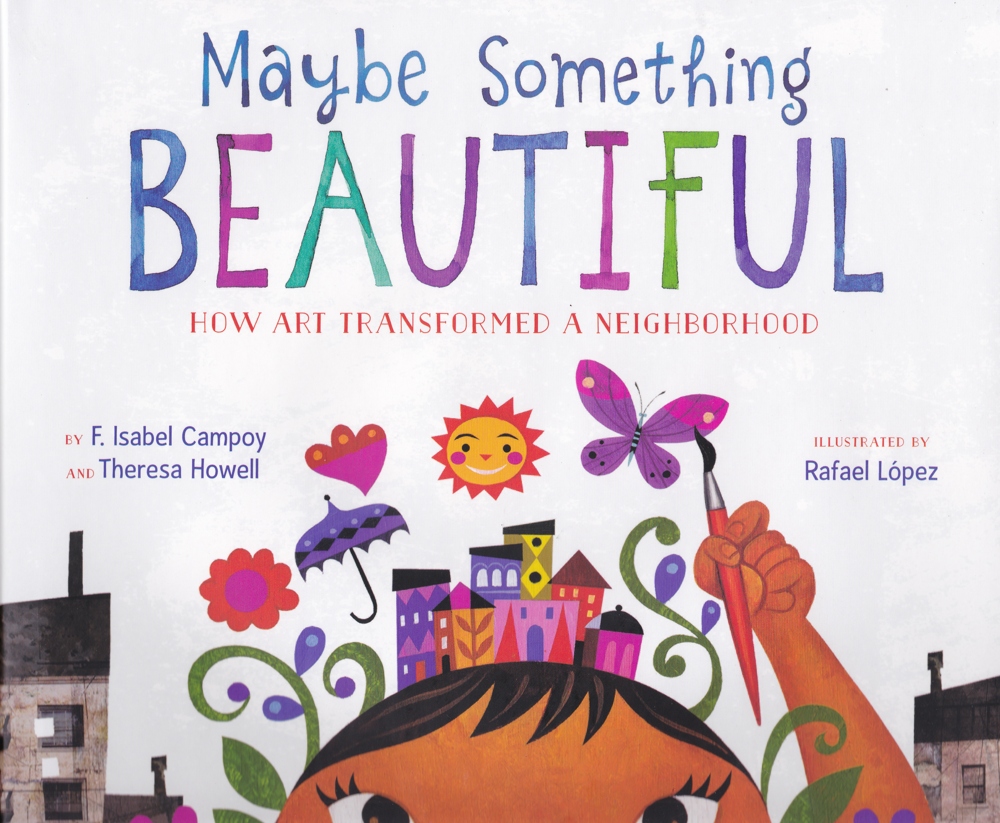 Story
Collection Green
Story
Collection Green Story
Collection Green
Story
Collection Green
To Order or to Ask a Del Sol
Question,
read the Del Sol Order
Info and then email Rey Del Sol
![]()
Story
Collection Green Books and CDs Spanish Set
$270.77,
Including 20%-Off, Free Immediate Mailing, and No Sales Tax
22 Books and 4 CDs : 4 Hardcover Bilingual Books, 1 Softcover Spanish Big Book, 2 Softcover Spanish Oversized
Books, 11 Softcover
Spanish Books, 4 Softcover Bilingual Books, 2 Spanish Music CDs, 1 Bilingual Music CD, and 1 Bilingual
Storytelling CD
Abecedario
de los animales, Softcover, Spanish, Big Book, Alma
Flor Ada, Vivi Escriva, Preschool and Up, 9780075765295, $25.00
Abecedario de
los animales, Spanish, Music CD, Suni
Paz, Preschool and Up, $12.50 Listen
Abeceloco,
Softcover, Spanish, Oversized Book, Alma
Flor Ada, Maria Jesus Alvarez, Preschool - 2nd Grade, 9781601283276,
$26.99
Antes
y ahora, Softcover, Spanish, Book, F.
Isabel Campoy,
Pam Schiller, Carol Newsom, Preschool and Up, 9781601283252, $7.99
Atentamente
ricitos de oro, Softcover, Spanish,
Book, Alma Flor Ada,
Leslie Tryon, Preschool and Up, 9781631139727, $13.95
Cristina
y la rana, Softcover, Spanish, Book, Alma
Flor Ada, Claudia Legnazzi, Preschool - 2nd Grade, 9781601283139,
$7.99
Cuadradito
azul - Little Blue Square, Softcover, Bilingual, Book, Alma
Flor Ada, Ulises Wenzell, Preschool and Up, $9.99
Daniel
y su mascota - Daniels
Pet, Softcover, Bilingual, Book, Alma Flor Ada,
G. Brian Karas, Preschool and Up, 9780152062439, $4.95 Listen
Diez
Perritos - Ten Little Puppies, Hardcover, Bilingual, Book, Alma
Flor Ada and F.
Isabel Campoy, Ulises Wensell, Preschool and Up, 9780061470431, $19.99
Extra
Extra, Softcover, Spanish,
Book, Alma Flor Ada,
Leslie Tryon, Preschool and Up, 9781631139611, $13.95
Gallo que fue a la boda de su tio,
Softcover, Spanish, Book, Alma Flor Ada,
Kathleen Kuchera, Preschool and Up, 9780698116832, $7.99
Gathering the
Sun, Softcover, Bilingual, Book, Alma Flor Ada,
Simon Silva, Rosa Zubizarreta, Preschool and Up, 9780688170677, $6.99 Watch
Listen
Listen
Gathering the Sun, Spanish,
Music CD, Suni Paz, Preschool and Up,
$12.50 Listen
Habia
una vez en Dragolandia, Softcover, Spanish, Book, Alma Flor Ada,
Sandra Lavandeira, Preschool and Up, 9781601282231, $9.99
Lagartija y el sol - The Lizard and the Sun,
Softcover, Bilingual,
Book, Alma Flor Ada,
Felipe Davalos, Rosa Zubizarreta, Preschool
and Up, 9780440415312, $7.99 Watch
Listen
Listen
Lugares
magicos, Softcover, Spanish, Book, Alma
Flor Ada, Ulises Wenzell, Preschool and Up, $9.99
Me
encantan los Saturdays y los domingos, Softcover, Spanish, Book, Alma
Flor Ada, Elivia Savadier, Preschool and Up, 9781631139635, $13.95
Mi
Dia de A a la Z, Softcover, Spanish, Book, F.
Isabel Campoy, Preschool and Up, 9781631139598,
$14.95
Misterioso huevo de
Daniel - Daniels Mystery Egg, Hardcover, Bilingual, Book, Alma
Flor Ada, G. Brian Karas, Preschool and Up, 9780152059668, $12.95 Listen
Moneda de oro - Gold Coin,
Bilingual, Storytelling CD, Alma
Flor Ada,
Preschool and Up, $19.95 Listen
Muu
Moo, Hardcover, Bilingual, Book, Alma Flor Ada and F.
Isabel Campoy, Vivi Escriva, Preschool and Up,
9780061346132, $16.99
Pio Peep, Hardcover,
Bilingual, Book and 16-Song Music CD, Alma Flor Ada and F.
Isabel Campoy, Vivi Escriva, Alice Schertle, Preschool and Up,
9780061116667, $16.99 Watch
Listen
Listen
Listen Listen
Quiero
ayudar - Let Me Help, Softcover, Bilingual, Book, Alma
Flor Ada, Angela Dominguez, Preschool
- 2nd Grade, 9780892392391, $8.95
Salta
Saltarin, Softcover, Spanish, Oversized Book, Alma
Flor Ada, F. Isabel Campoy, Claudia Legnazzi, Preschool - 2nd Grade,
9781601283290,
$22.99
Unicornio del oeste,
Softcover, Spanish, Book, Alma
Flor Ada, Preschool and Up,
9781416968443, $11.99
Story
Collection Green Books and CDs English Set
$168.44, Including
20%-Off, Free Immediate Mailing, and No Sales Tax
14 Books and 2 CDs : 5 Hardcover
English Books, 8 Softcover English Books, 1 Bilingual Book, 1 English Storytelling CD, and 1
Bilingual Storytelling CD
Dear
Peter Rabbit, Softcover, English, Book, Alma
Flor Ada, Leslie Tryon, Preschool and Up, 9781416912330, $4.99 Watch
Extra
Extra, Hardcover, English, Book, Alma
Flor Ada, Leslie Tryon, Preschool and Up, 9780689825828, $17.99 Watch
Gold Coin, Softcover, English, Book, Alma
Flor Ada, Preschool and Up, 9780689717932, $6.99
Gold
Coin - Moneda de oro, Bilingual, Storytelling CD, Alma
Flor Ada, Preschool
and Up, $19.95 Listen
I
Love Saturdays y domingos, Softcover, English, Book, Alma
Flor Ada, Elivia Savadier, Preschool and Up, 9780689874093, $7.99 Watch
Malachite
Palace, Hardcover, English, Book, Alma
Flor Ada, Preschool and Up, 9780689319723, $16.95 Watch
Malachite
Palace, Jordis Star, and Unicorn of the West, English, Storytelling CD, Alma
Flor Ada, Preschool
and Up, $19.95 Listen
Maybe
Something Beautiful, Hardcover, English, Book, F.
Isabel Campoy, Theresa Howell, Rafael Lopez,
Preschool and Up, 9780544357693, $16.99
My
Day from A to Z, Softcover, English, Book, F.
Isabel Campoy, Preschool and Up, 9781603963244, $14.95
Rooster
Who Went to His Uncles Wedding, Softcover, English, Book, Alma
Flor Ada, Kathleen Kuchera, Preschool - 2nd Grade, 9780698116825, $7.99 Watch
Quiero
ayudar - Let Me Help, Softcover, Bilingual, Book, Alma
Flor Ada, Angela Dominguez, Preschool
- 2nd Grade, 9780892392391, $8.95
Rosa
Raposa, Hardcover, English, Book, F.
Isabel Campoy, Jose Aruego and Ariane Dewey, Preschool and Up,
9780152021610, $16.95 Watch
Three
Golden Oranges, Softcover, English, Book, Alma
Flor Ada, Reg Cartwright, Preschool and Up, 9781442474963, $16.99
Unicorn
of the West, Hardcover, English, Book, Alma
Flor Ada, Preschool and Up, 9780689317781, $16.95 Watch
With
Love Little Red Hen, Softcover, English, Book, Alma
Flor Ada, Leslie Tryon, Preschool and Up, 9780689870613, $7.99 Watch
Yours
Truly Goldilocks, Softcover, English, Book, Alma
Flor Ada, Leslie Tryon, Preschool and Up, 9780689844522, $7.99 Watch
Additional Book Formats
Antes
y ahora, Softcover, Spanish, Oversized Book, F.
Isabel Campoy,
Pam Schiller, Carol Newsom, Preschool and Up, 9781601283238, $22.99
Con
Carina Amalia, Hardcover, Spanish, Book, Alma Flor Ada,
Gabriel Zubizarreta, 3rd Grade and Up, 9781442424050, $15.99
Dancing Home,
Hardcover, English, Book, Alma Flor Ada,
Gabriel Zubizarreta, 3rd Grade and Up, 9781416900887, $14.99 Watch
Watch
Dear
Peter Rabbit, Softcover, English, Book, Alma
Flor Ada, Leslie Tryon, Preschool and Up, 9780689812897, $7.99 Watch
Dear
Peter Rabbit, Hardcover, English, Book, Alma
Flor Ada, Leslie Tryon, Preschool and Up, 9780689318504, $17.95 Watch
Gathering the
Sun, Hardcover, Bilingual, Book, Alma Flor Ada,
Simon Silva, Rosa Zubizarreta, Preschool and Up, 9780688139032, $17.99 Watch
Listen
Listen
I
Love Saturdays y domingos, Hardcover, English, Book, Alma
Flor Ada, Elivia Savadier, Preschool and Up, 9780689318191, $19.99 Watch
Love
Amalia, Hardcover, English, Book, Alma Flor Ada,
Gabriel Zubizarreta, 3rd Grade and Up, 9781442424029, $15.99
My Name is Maria Isabel,
Hardcover, English, Book, Alma
Flor Ada, K. Dyble Thompson, 2nd Grade and Up,
9780689315176, $17.95 Watch
Nacer
Bailando, Hardcover, Spanish, Book, Alma Flor Ada,
Gabriel Zubizarreta, 3rd Grade and Up, 9781442420618, $14.99 Watch
Watch
Rooster Who Went to His Uncles Wedding,
Hardcover, English, Book,
Alma Flor Ada,
Kathleen Kuchera, Preschool and Up,
9780689825811, $17.99 Watch
With
Love Little Red Hen, Hardcover, English, Book, Alma
Flor Ada, Leslie Tryon, Preschool and Up, 9780689870613, $17.99 Watch
Yours
Truly Goldilocks, Hardcover, English, Book, Alma
Flor Ada, Leslie Tryon, Preschool and Up, 9780689816086, $17.95 Watch
If you want to
choose individual titles instead of entire sets, then feel free to do so at the
same 20%-Off, with Free Immediate Mailing and No Sales Tax. Email
Rey Del Sol
If you need to buy
in quantity, then feel free to request almost any US Book at the
same 20%-Off, with Free Mailing and No Sales Tax. Email
Rey Del Sol
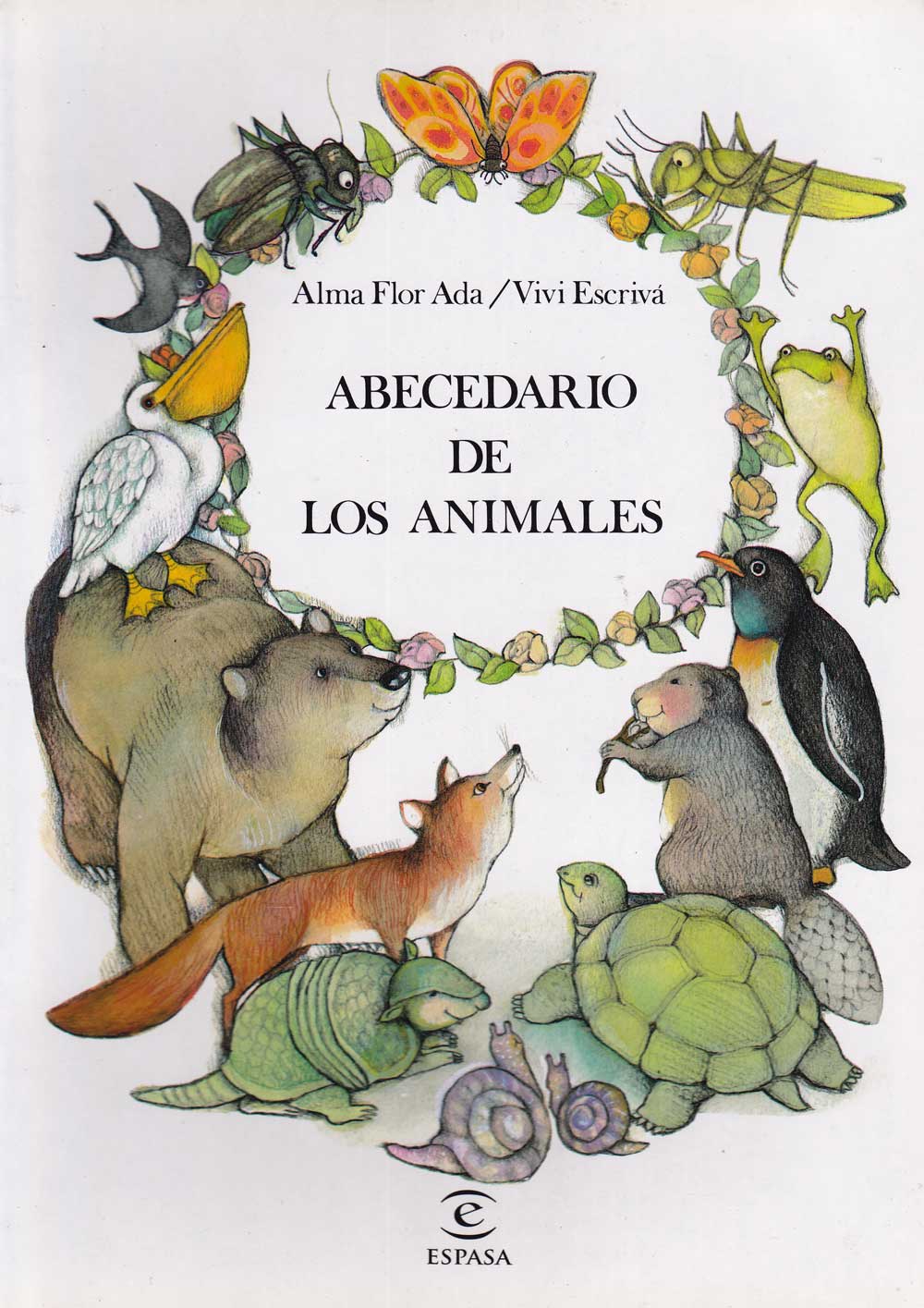 Abecedario
de los animales
Abecedario
de los animales
The Abecedario CD, with lyrics by Alma Flor Ada and music by Suni Paz, offers a song for each letter of the alphabet. The songs center on the letters, playfully exploring associated shapes as well as meaningful words which contain the sound represented by them. These charming songs can facilitate the development of phonemic awareness for children who are beginning to acquire literacy, as well as joyful recognition for those already literate. For her musical creations, Suni Paz draws from her extensive knowledge of Latin American and Spanish musical tradition making this CD and all CDs in the series a powerful introduction to the Hispanic musical heritage.
A companion book to Coral y espuma abecedario del mar, this book offers two poems for each letter of the alphabet. One poem centers on the featured animal, while the other focuses on the letter itself, playfully exploring associated sounds and shapes and meaningful words. Teachers and children have delighted on this book which has become one of Alma Flor’s classics, with numerous reprints both in hardcover and paperback. Viví Escrivá whimsical illustrations contribute to make this book a favorite welcoming present for a new born child, a special birthday present or simply a book that belongs in the library of every child who speaks or is learning to speak Spanish.
The accompanying CD complements the book, facilitating children’s retention of the poems. Drawing on her broad knowledge of the Hispanic musical tradition, Suni Paz has turned each of the alphabet poems into a delightful song. The songs encompass a wide range of Latin American and Spanish rhythms, and provide an outstanding introduction to Latino children’s vast musical heritage. The tape also includes an original ABC song, a gift from Alma Flor and Suni to children and teachers.
Author’s Note : The ABC has always held great appeal for me. I love that it is such a wonderful tool for organizing things. I am a lover and collector of ABC books, so it is not a surprise that I have written a few.
This particular ABC was born out of my desire to do something special for a special child, Emilio, the son of Kuki Miller and Daniel
Divinski, two wonderful Argentinian friends. Emilio was visiting San Francisco for the first time, and I had been looking forward meeting this child, but feel victim of the most vicious flu. It was frustrated to be in bed and not able to meet the child and take him and his mother to see the city. To try to give him something, I began creating poems about the letters and sharing them with him on the phone. This was the inspiration for the book.
At a different level this book is very important to me because it was the beginning of my professional association with someone I held in great esteem, Felicidad
Orquín. A specialist in Children’s Literature, and a remarkable author, Felicidad was at the time the Director of the Children’s Literature Section of Espasa-Calpe in Madrid, and was the person who offered me a contract to publish this book. Since then we have become friends, but this book was out first contact. The book is the product of her vision who selected Viví as the illustrator and designed the parameters for the book design. The collaboration with Viví on the creation of the book, and with Suni Paz on the creation of the tape have been extraordinary joys in my life.
Even more exciting is the fact that many children have been inspired to write their own ABC poems after reading this book. That is the greatest of all rewards!
My great love for this book derives, of course, of the extraordinary response it has had from teachers and children. It has been wonderful to visit schools and see how children knew the poems by heart, and could recite or sang them. Once in the outstanding Author’s Fair of St. Helena’s Elementary School, in St. Helena, California, the children perform the book on stage, holding big signs with the letters and moving to a wonderful choreography. I also have many children made versions of the book.
Publishers Weekly : Young readers will enjoy learning the alphabet as they associate the letters with the names of animals. Large, colorful illustrations and simple, clever text make this a fun and educational tool.
School Library Journal : A wonderful collection of verses about the letters of the alphabet, including imaginative descriptions of the letters and an introduction to their sounds. The text is enhanced by beautiful watercolor illustrations.
Listen to a sample song from Abecedario de los animales' 29 songs by clicking on the highlighted CD title below.
29-Song Abecedario de los Animales CD
La A
La B
La C
La Ch
La D
La E
La F
La G
La H
La I
La J
La K
La L
La LL
La M
La N
La ñ
La O
La P
La Q
La R
La S
La T
La U
La V Listen
La W
La X
La Y
La Z
Abecedario completo en canción (The complete ABCs)
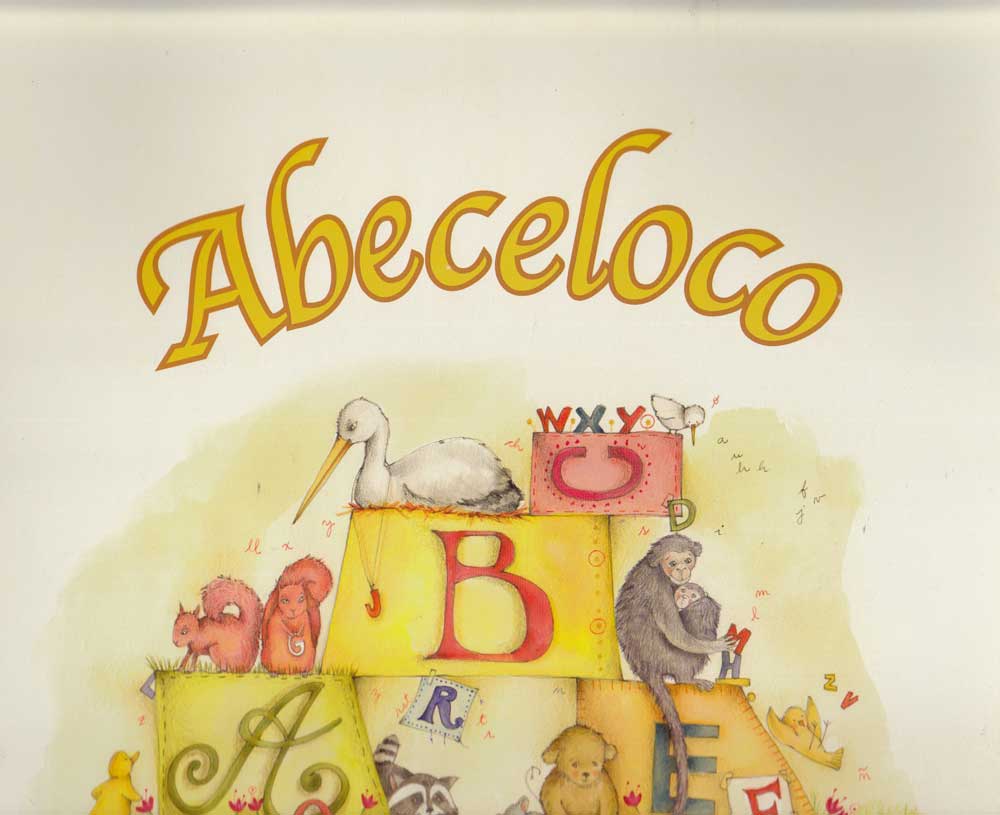 Abeceloco
Abeceloco
María Jesús Álvarez brings the charming animals in Alma Flor Ada’s alphabet book to life. Enjoy the rhyming conversation as you meet each one.
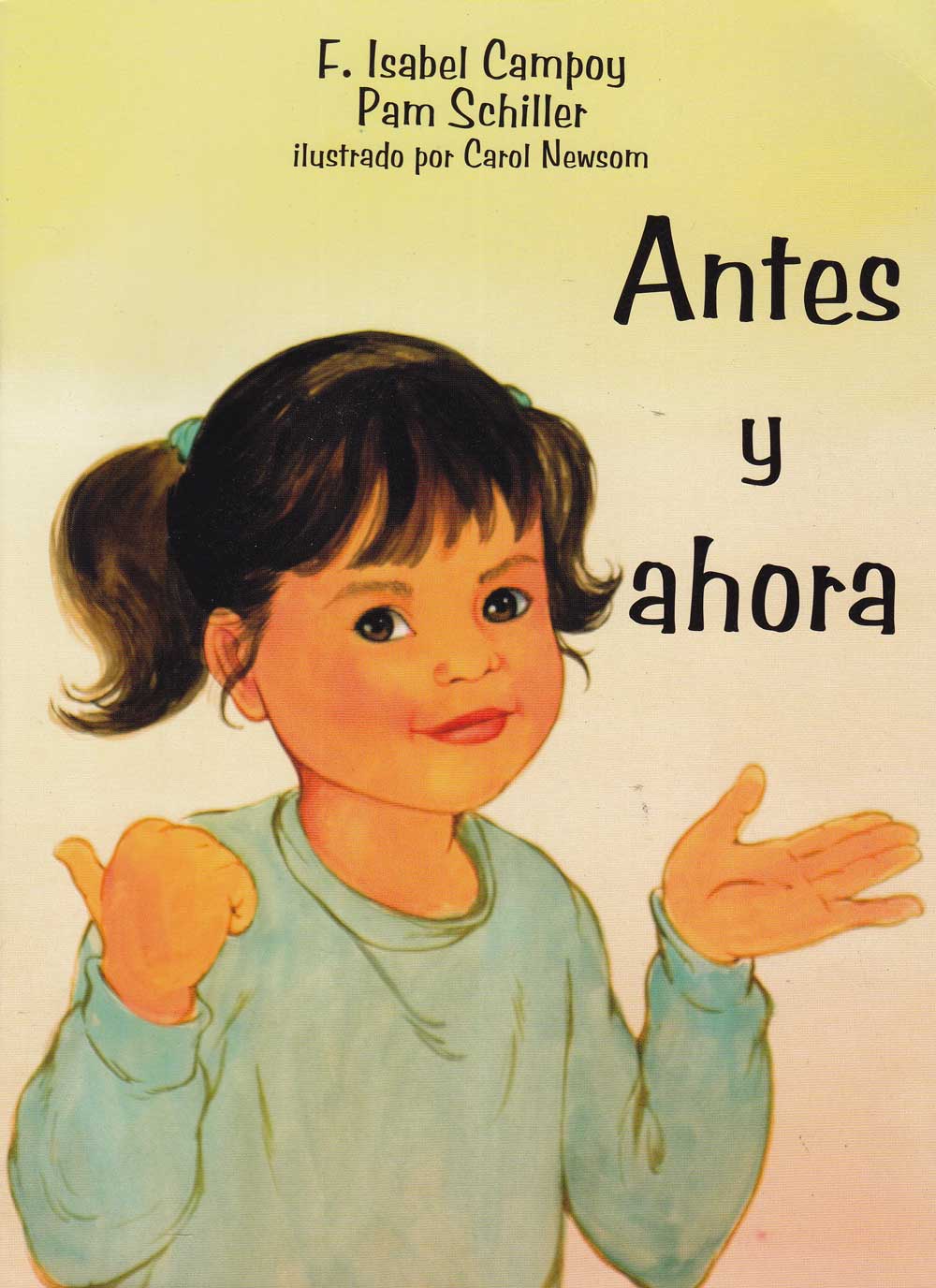 Antes
y ahora
Antes
y ahora
Before and Now is a celebration of growth. Two children document their accomplishments as they remember what they could do before and what they can do now. It is a perfect read for children transitioning into kindergarten.
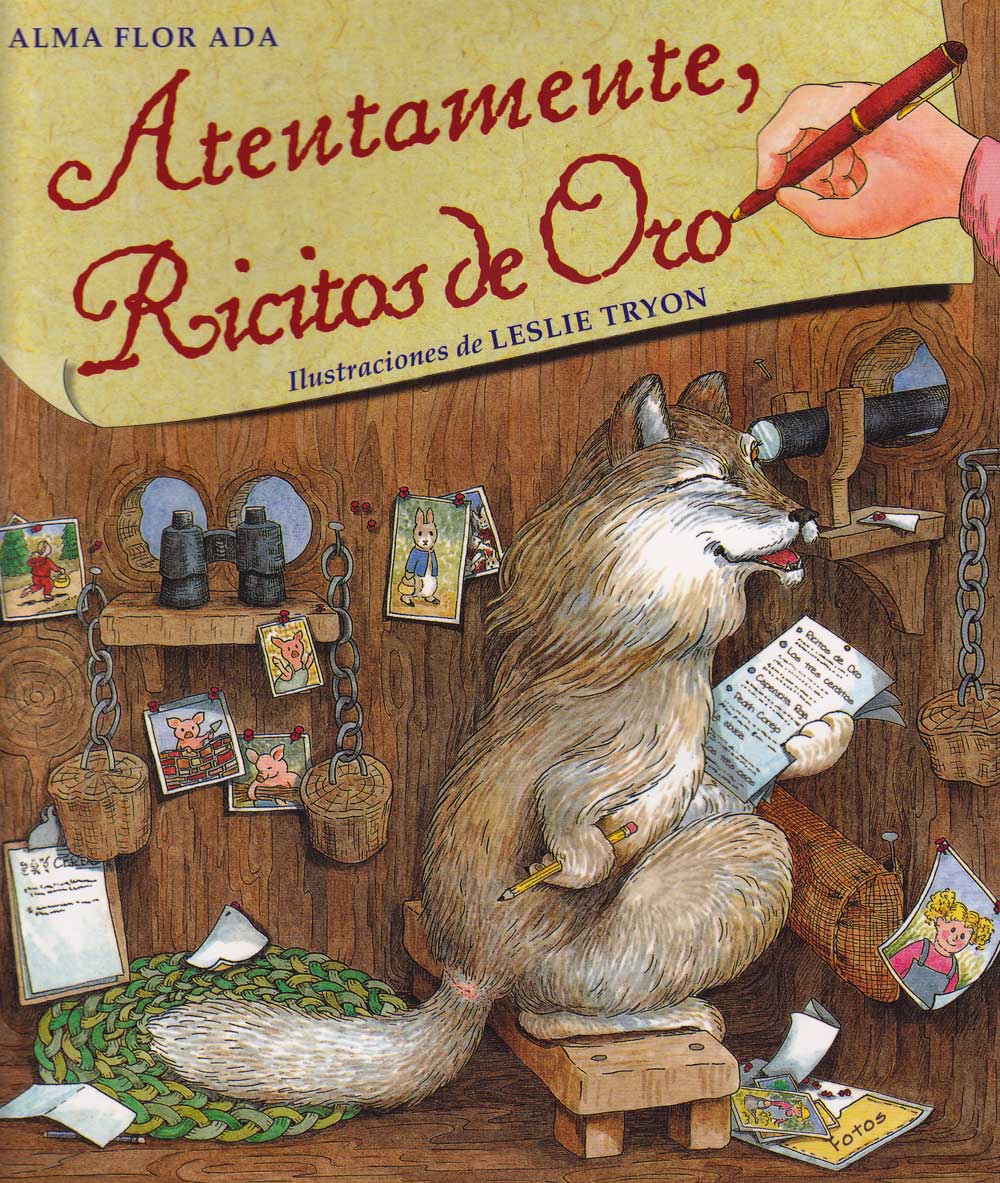 Atentamente
ricitos de oro
Atentamente
ricitos de oro
Yours Truly Goldilocks
In this sequel to Dear Peter Rabbit we return to Hidden Forest with another delightful series of letters between some of the best-loved characters of children’s books, including Goldilocks, the Three Bears, Little Red Riding Hood, the Three Little Pigs and their pursuers Fer O’Cious and Wolfy Lupus.
Author’s Note : Leslie Tryon outdid herself in the illustrations of these books. The endearing portraits she had created in Dear Peter Rabbit are here surrounded by minute details which make me want to look at the illustrations over and over again. “Hidden Forest” became a reality in this book.
Watch or Listen to Vienna Rose read Yours Truly, Goldilocks to you. A marvelous example of the magical encounter between a child and books that we wish for all children. And here's an
earlier reading by Vienna Rose, and an
even earlier
reading, and the earliest
reading.
Publishers Weekly : In this sly picture book, Ada and Tryon make a return visit to the storybook backdrop of their Dear Peter Rabbit. While the sequel succeeds as a stand-alone, it offers double the fun in tandem with its predecessor. The exchange of letters among familiar characters. Goldilocks, the Three Little Pigs, Peter Rabbit, Little Red Riding Hood, Baby Bear and, of course, the Big Bad Wolf
(aka Fer O'Cious) continues as the pigs invite their pals to their new, wolf-proof home for a housewarming party. The wolf, however, has been spying on the pigs, and he hatches a plan of his own, suggesting that his cousin join him in an ambush. But the wolves haven't counted on Baby Bear's mother and her swift reflexes. The mixing and matching of nursery favorites provides a lively framework for the epistolary conceit and allows even the youngest readers access to the inside track. Amusing details, meanwhile, hook older readers (Goldilocks, for instance, is imagined as Mr. McGregor's daughter, and resides on Veggie Lane). Tryon enriches her delicate pen-and-ink and watercolor illustrations with an abundance of delicious visual tidbits, as in the cover art, which shows the wolf on a stakeout, peering through a telescope at his prey. The ending hints of more adventures to come. A good news indeed. Ages 4-8.
School Library Journal : Kindergarten-Grade 3A Like Dear Peter Rabbit (Atheneum, 1994), this charming book tells its story through an exchange of letters. Here Ada chronicles the attempt of the three little pigs to plan a housewarming party. Meanwhile the villains from the previous title are still up to no good, spying on the residents of the forest and planning an attack on the homeward-bound guests. Fortunately, the surprise is on them and the two wolves lose both their pride and their fur. This is fairy-tale fun at its best. Following these well-loved characters on a new adventure tickles the imagination with fanciful "what ifs." Tryon's wonderfully intricate colored drawings, with their delightful details and carefully wrought scenarios, bring the action to life. Perspective plays an important role in many of the pictures, from the wolf's telescope-lens view of his victims, to an interior scene of Peter Rabbit's den. Warm colors and sharp details pull readers right into the Hidden Forest. The climactic scenes are on wordless double-page spreads that perfectly convey a sense of frivolity and fear, while the final letter leaves readers hoping for yet another installment. Get on the mailing list for these letters.
Booklist : Ages 4-7. In this sequel to Dear Peter Rabbit (1994), a housewarming party is planned for the Three Little Pigs through a series of letters between the pigs, Goldilocks, Baby Bear, and Little Red Riding Hood. But the fairy tale characters aren't the only ones exchanging letters. Big, bad cousins Wolfy Lupus and Fer O'Cious have heard about the party and are writing each other with some plans that spell trouble for the party goers. The letter format is a bit confusing at first but will gain appeal as kids get the characters straight in their minds. Each attractive two-page spread features a letter and a facing full-page picture of the letter writer, often shown in some action that extends the story. Fans of the previous book or lovers of fractured fairy tales will be the book's natural audience.
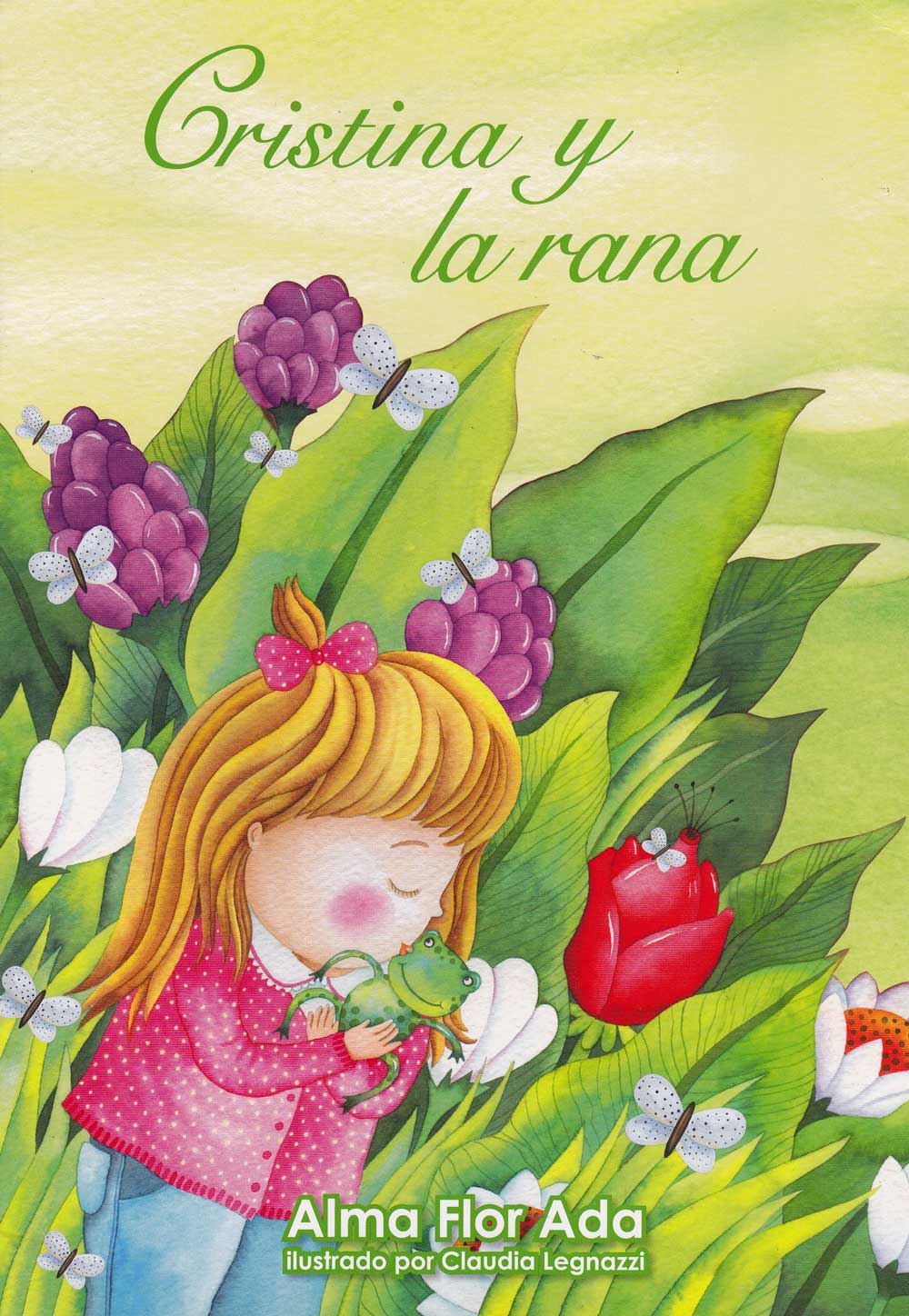 Cristina
y la rana
Cristina
y la rana
Alma Flor Ada’s granddaughter Cristina inspired this twist on the classic The Frog Prince. Cristina finds a frog and kisses it—hoping, not for a prince, but for a playmate. Imagine her surprise when a baby arrives instead.
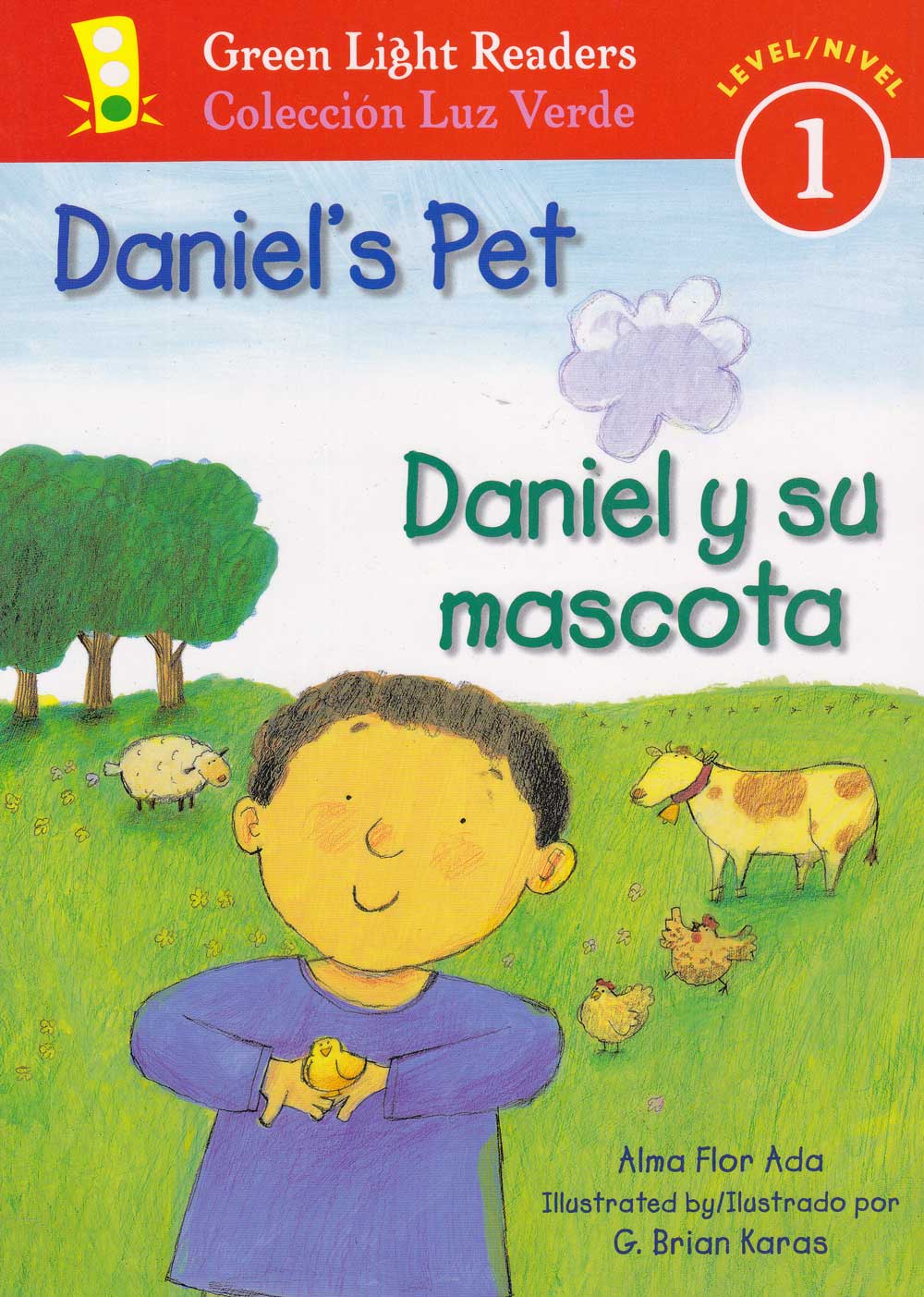 Daniel y su mascota - Daniels Pet
Daniel y su mascota - Daniels Pet
Daniel loves his new pet. But what will happen when it hatches a surprise? Alma Flor Ada and G. Brian Karas team up for a heartwarming story about Daniel and his newest animal friend.
Children’s Literature : Those learning to read often turn to books that explore their interests. Keeping this in mind, Harcourt last year launched a carefully designed early-reader series called "Green Light Readers" with level one (ages 4 to 6) and level two (ages 5 to 7) books. Since many kids are intrigued by animals, Daniel's Pet heads the list. The book offers the simple words, fun rhymes and rhythms and familiar situations that can provide important cues to those trying to master reading. Alma Flor Ada's engaging story about a little boy acquiring and caring for his pet chick is well complemented by G. Brian Karas' whimsical illustrations. At the end, an art project and five playful questions encourage young readers to further reflect on the book, enhancing understanding and enjoyment. 2003, Harcourt, and Ages 4 to 6.
Boston Sunday Herald : "A must-have for any family with a beginning reader."
School Library Journal : "You can't go wrong with adding several copies of these terrific books to your beginning-to-read collection."
Booklist : "A winner for the beginner."
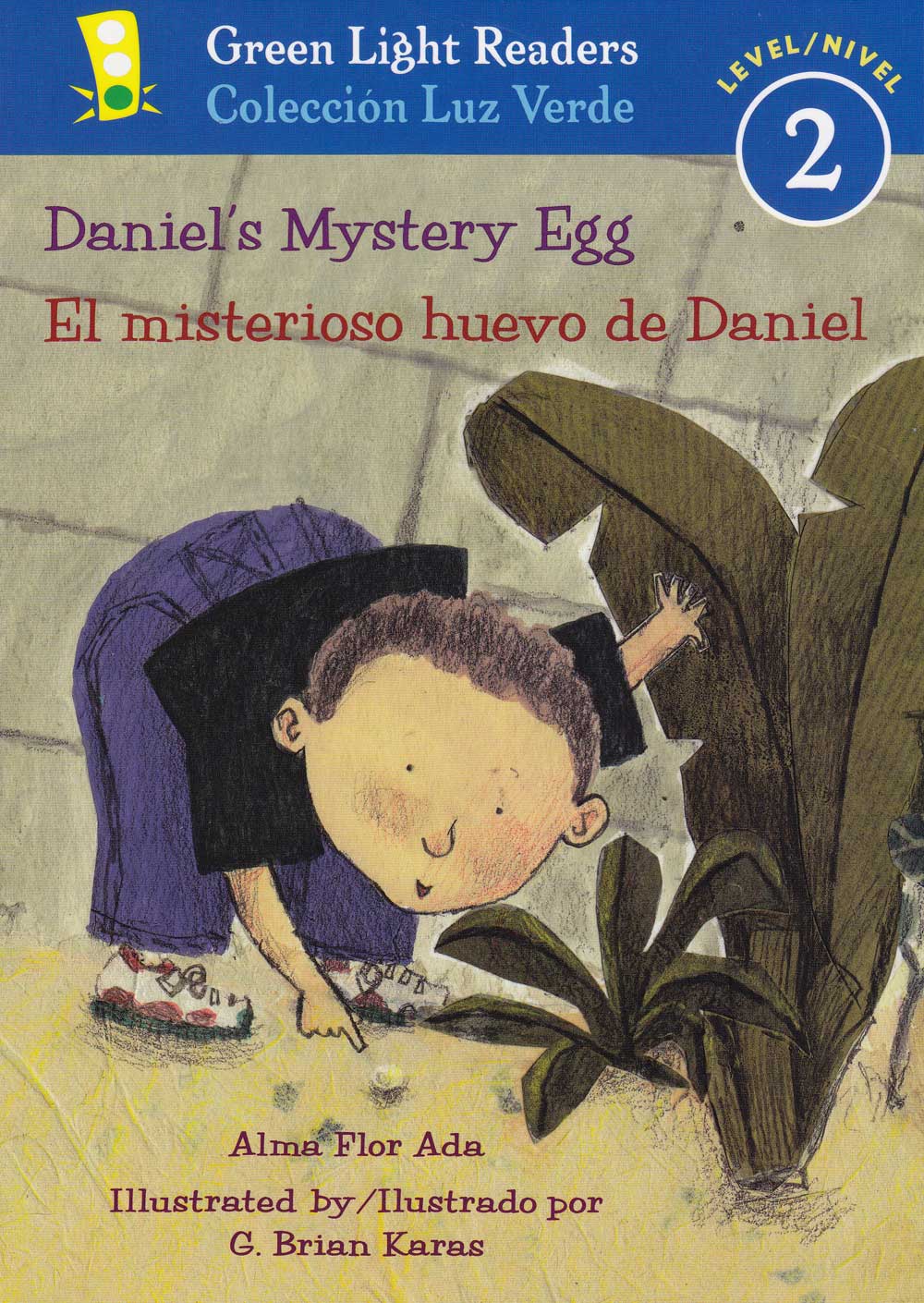 El misterioso huevo de Daniel - Daniels Mystery Egg
El misterioso huevo de Daniel - Daniels Mystery Egg
Daniel finds an egg. What kind of animal will this mystery egg hatch? Imaginations run wild as the kids in Daniel’s class guess what sort of surprise the egg has in store. Teachers comment that this is an excellent book to practice prediction, since Daniel’s friends are actually predicting which animal may hatch from the surprising egg. Of course they are also enjoying it as a book to talk about animals who hatch from eggs. Some teachers have paired this book with another of Alma Flor’s books : Who's Hatching Here? - ¿Quién nacerá aquí?
School Library Journal : Grade 1-2. An appealing story in which a boy finds a small white egg. He shows it to three friends, one at a time. Each child speculates as to what might be inside and how to help once it has hatched. After some waiting, what emerges is not an ostrich or an alligator or a duck, as his friends imagined, but a lizard, exactly the kind of animal Daniel predicted-"small, nice, and quiet." Karas's collages cover three-fourths of each spread or page and are either above or below the text. Most are in full color, with the exceptions being the illustrations that represent what the three imagine is in the egg. Those pictures are more muted and depict the kids peeking over the edges of the scenes. With large-sized type, short sentences, repeated words and phrases, and plenty of illustrations, this book is just right for beginning readers.
Booklist : Grade 1-2. Daniel finds a little egg, puts it in a box, and shows it to his friends as they come along. The children suggest one dangerous or inconvenient animal after another that might be inside the egg, but Daniel expects a small, nice, quiet pet. To the boy's great satisfaction, the egg hatches and a lizard emerges. Written with a simple vocabulary and growing sense of anticipation, this story will suit beginning readers well. Karas' stylized illustrations, collages of cut paper enhanced with drawing and painting, clearly delineate between the actual and imagined scenes. A pleasing entry in the Green Light Reader series.
G. Brian Karas has illustrated dozens of popular books. For this book he used photos of Alma Flor’s grandson Daniel to illustrate the protagonist which Daniel inspired.
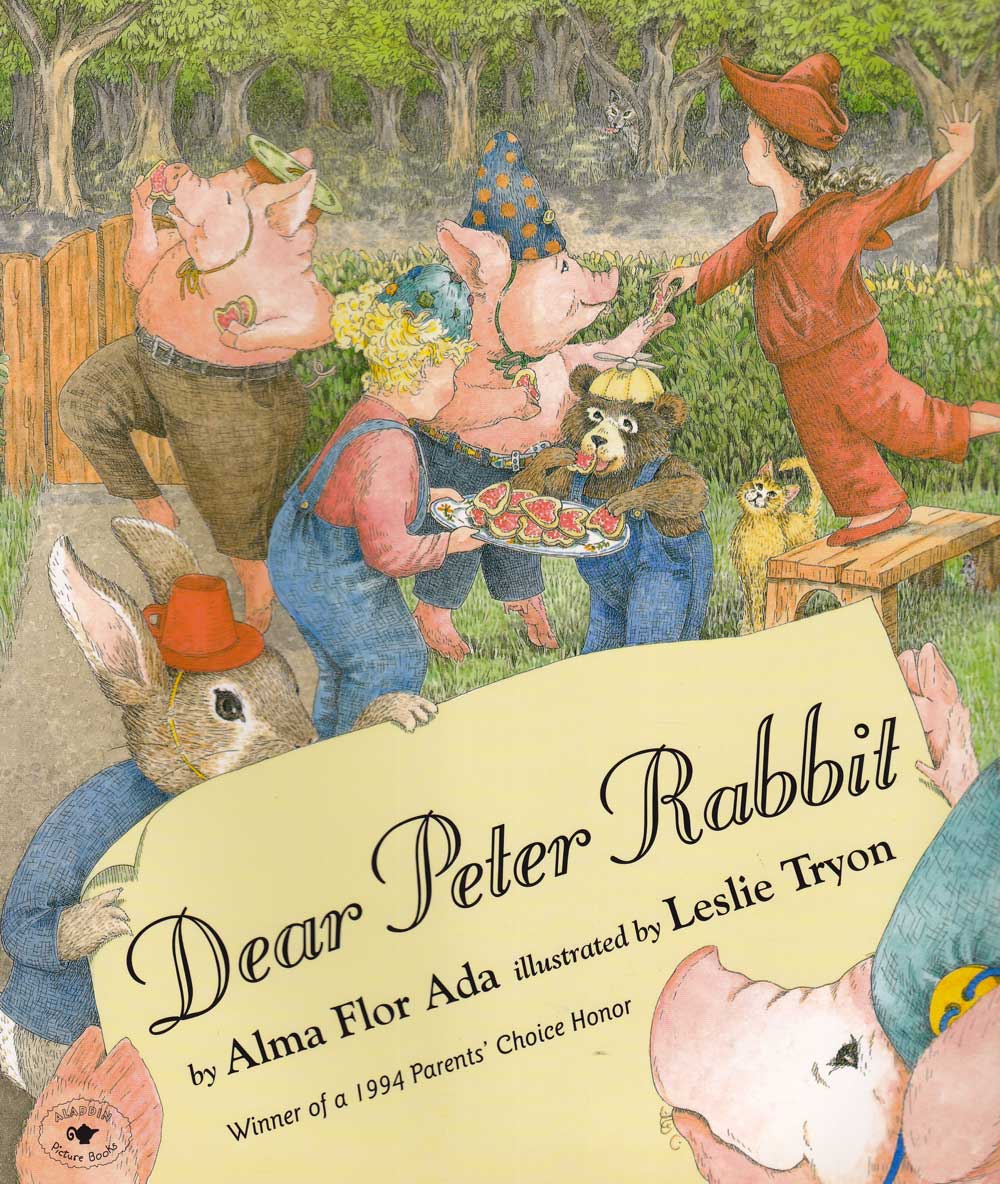 Dear
Peter Rabbit
Dear
Peter Rabbit
American Booksellers
Association, Pick of the List
Parents’ Choice Honor Award
This lively collection of letters written by famous storybook characters takes us behind the scenes in the land of make-believe. One of the Three Little Pigs is hosting a housewarming, and Peter Rabbit would love to go. But he's in bed with a cold after a narrow escape from Mr. McGregor's garden. Meanwhile, Goldilocks is planning her birthday party and hoping her new friend Baby Bear can come (he's forgiven her for breaking his favorite chair). But with the Big Bad Wolf on the prowl and Little Red Riding Hood heading off to grandmother's house, there's no telling how things may end!
Author’s Note:
Little could I have imagined that a playful act to keep me
Listen to Vienna Rose read Dear Peter Rabbit to you. A marvelous example of the magical encounter between a child and books that we wish for all children. And here's an earlier reading and an earlier reading by Vienna Rose, and an even earlier reading, and the earliest reading.
Written Windows :I love a good fairy tale and the old ones by Beatrice Potter are definitely a favorite. Alma Flor Ada has taken some of these beloved stories and added a neat twist - interlocking all the stories and written as letters between friends. Pig One and Peter Rabbit, Goldilocks and Baby Bear all writing letters to one another about how Pig One and Pig Two's house was destroyed and how Peter got a cold when escaping from Mr. McGregor's garden. Later you find out that Goldilock's last name is McGregor and she helps poor Peter by putting his coat on the fence for him. There is so much story line in the book it makes for a wonderful read - well, I enjoyed it more than my almost 3 year old, but she doesn't know the old stories in detail like I do since I have several more years of knowing them under my belt. :) To sum it up, this is a great book and I hope you'll try it and take a fun twist on some old characters
Publishers Weekly :
Reminiscent of Janet and Allan Ahlberg's hugely successful The Jolly Postman ,
this clever picture book creates a fictitious flurry of correspondence between
such familiar characters as Goldilocks (here given the surname McGregor, with a
wink and a nod to Beatrix Potter), the Three Pigs, Baby Bear, Red Riding Hood
and Peter Rabbit. As the plot thickens (will Goldilocks make a return visit to
the Bears' house? Will Peter Rabbit be well enough to attend the Three Pigs'
housewarming party?), Ada inventively weaves together the criss-crossing
letters, neatly tying up the loose ends with a finale wherein the entire
assembly (except for the now-tailless wolf) shows up for Goldilocks's birthday
party. Ada clearly had fun extrapolating the characters' private lives, and her
sunny treatment finds ready companionship in Tryon's delicately colored,
lovingly detailed pen-and-ink and watercolor art. A Spanish edition, Querido
Pedrin , is being issued simultaneously. Ages 5-8.
School Library Journal : PreSchool-Grade 3-A series of lively letters penned by
beloved storybook characters tells an entertaining and imaginative tale. As the
Big Bad Wolf lurks just out of sight, Pig One writes to Peter Rabbit, inviting
him to a housewarming party at his newly built straw house. Meanwhile, Baby Bear
sends Goldilocks a note asking her to visit, admonishing her to "knock on
the door first before you come in." In reply, Goldilocks McGregor writes
about vegetables missing from the garden and the "tiny jacket" and
"tiniest pair of shoes" found by her father. Peter sends his regrets
to Pig One; he caught cold while hiding from Mr. McGregor in a
"half-full" watering can. Not to worry, due to uncontrollable
circumstances the party will take place at Stick House at a later date. The
chatty correspondence continues, culminating in a birthday party that brings the
characters face to face. Carefully weaving together the lives of these literary
favorites into a seamless plot, Ada uses familiar elements to create a
convincing and intriguing make-believe world. In addition to being fun to read,
the letters move events along quickly and create a unique voice for each author.
Tyron's inviting illustrations, rendered in pen and ink with watercolors, add
both detail and dimension. Whether author or recipient is depicted, the pictures
include and expand on the contents of each letter. Drawings of Peter Rabbit and
Mr. McGregor are appropriately reminiscent of Beatrix Potter's originals.
Children will be enchanted by this opportunity to meet familiar faces in new
settings.
Booklist : Ages 3-6. Ada uses an amusing conceit to add to children's knowledge
of the fairy-tale world. The text is a series of letters between such favorites
as Peter Rabbit, Goldilocks, and one of the three little pigs, and there's even
a hasty note from one big bad wolf to another. The letters loosely constitute a
story, but it is the cozy feeling of seeing inside these characters' lives that
is the book's real selling point. Tryon's ink-and-watercolor illustrations are a
delightful complement to the letters, fresh and filled with the detail that
brings a reader back for a second and third look. Especially amusing is the
two-page spread featuring the letter from the three little pigs' wolf to Red
Riding Hood's wolf, which reads in part: "Perhaps we would do well to
change our diet. It is not a pleasant prospect, but it may be in our interests
to avoid both young girls and pigs from now on." The picture shows a glum
wolf having a replacement tail sewn on after the pigs have chopped off the
original and used it for soup.
Kirkus Reviews : The events in four familiar tales are cleverly intertwined and
reported in a dozen letters. ``Pig One'' invites Peter Rabbit to a housewarming,
but he can't go because he's in bed sipping camomile; Baby Bear wants his new
friend Goldilocks McGregor to visit; Pigs One and Two report that they're now
safely with Pig Three; Peter gets an unexpected invitation from Goldilocks and
compliments the three pigs on the wolf's-tail soup served at the housewarming
they finally managed to celebrate; the wolf orders a new tail and swears off
pigs and little girls. Red Riding Hood wraps up events in a letter to her
grandmother, while Tryon (Albert's Alphabet, 1991, ALA Notable) visualizes them
in an inviting fairy-tale world, gently recalling both Gustave Dor‚ and
Beatrix Potter with entrancing, delicately colored crosshatched detail. In
addition to more obvious uses, try a dramatic reading of these pleasingly
childlike letters.
San Francisco
Chronicle : “Alma Flor Ada, a prolific author of bilingually published
children’s books, makes a whimsical and original contribution with Dear Peter
Rabbit, simultaneously
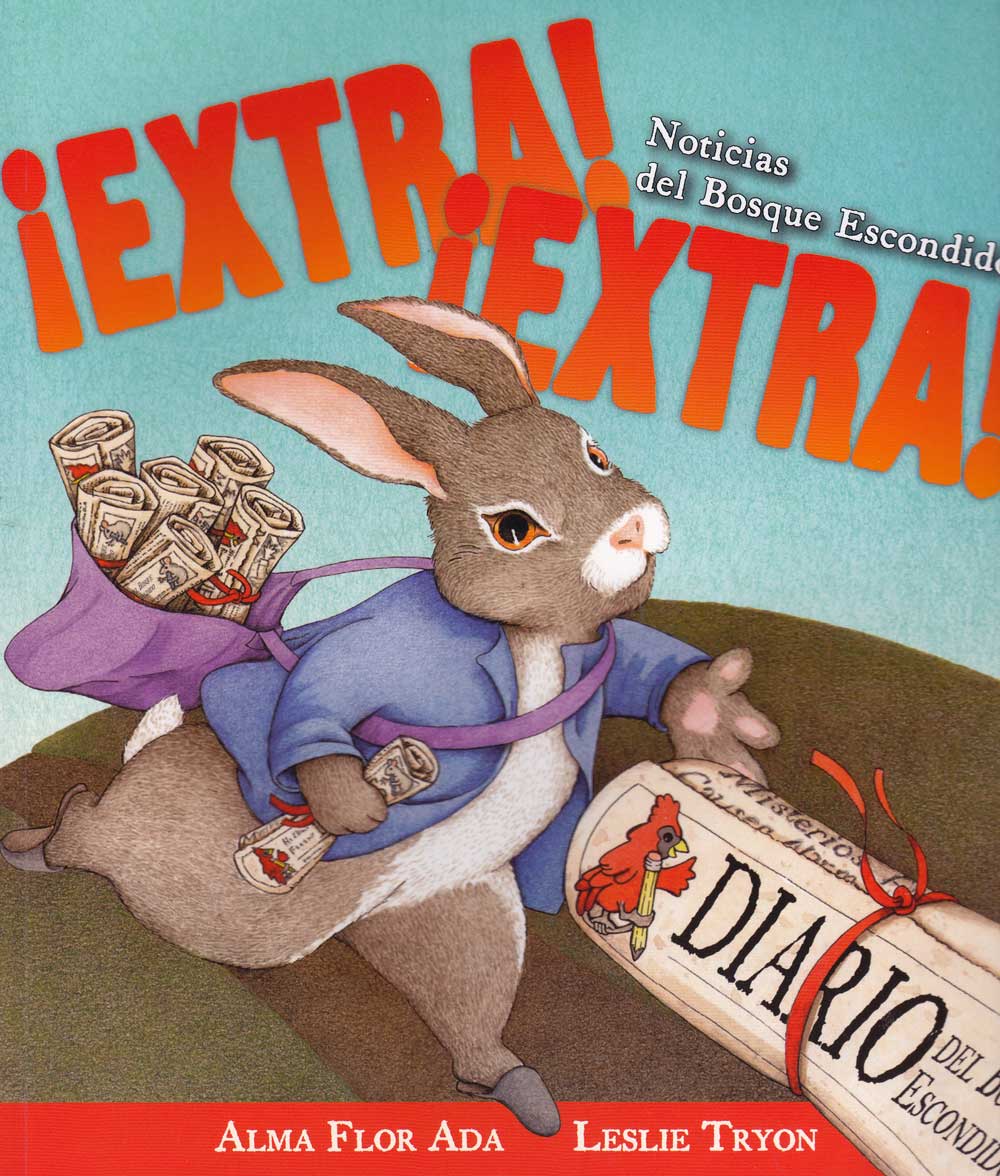 Extra
Extra
Extra
Extra
When the residents of Hidden Forest wake up and open their morning papers, they are in for a surprise. An enormous beanstalk has mysteriously sprouted outside of Jack Blake's house, and Jack is nowhere to be found. Meanwhile, Pinocchio and Half-Chicken have set out on adventures of their own, and Tortoise and Hare are off to the races. Will they all find their happy endings? Hidden Forest News has got the scoops. Written and laid out in newspaper format, this installment in the enchanting Hidden Forest series has received a new twist from Alma Flor Ada and Leslie Tryon. All of your favorite characters from Dear Peter Rabbit; Yours Truly, Goldilocks; and With Love, Little Red Hen are back, but this time they are hitting the presses and making headlines!
Author's Note : Publishing a book is always a long process, but sometimes it can be a VERY long process. That was the case of my latest book: Extra! Extra! Fairy-Tale News from Hidden Forest. Due to a series of mishaps, it took 9 long years to go from a manuscript to a book. But, now rejoicing in the great art of Leslie Tryon, it was worth the wait. This is a book I have gotten to like and love more each day...because it was born out of my love for newspaper --granddaughter of two newspaper men that I am-- and because I believe that while fun and entertainment it will give children an opportunity to see two sides of an argument, and also to learn to read critically. When a giant beanstalk appears in Hidden Forest the town gets divided between those who feel that anything different is a menace that should be eliminated, and want to chop down the beanstalk immediately, and those who propose that there may be richness in diversity...
Listen to Vienna Rose read Extra Extra to you. A marvelous example of the magical encounter between a child and books that we wish for all children.
Xomba : Is your child REALLY into the classics? By classics, I'm talking about Fairy Tales. Has your child asked for the same fairy tale to be read to him over and over? Are you getting tired of reading these fairy tales, and looking for something new, but your child insists on the fairy tales? If that sounds like your house lately, you might try this. Read them Extra! Extra! Fairy Tale News from Hidden Forest, by Alma Flor Ada. Yes, this still delves into the genre of fairy tales, but at least you'll get a break from the way they are delivered. You see, in this book, it can come right to your doorstep, and Fido can bring it to your lap, in the form of a newspaper! Take a break from the regular old fairy tales, and enjoy this newspaper version, which mostly centers around Jack and his bean stalk, and just what they are going to do about the eyesore and danger that is ever present, and continuing to grow even taller and more threatening in their neighborhood. That, and Jack is missing! Will they ever find him? But it's not just about Jack. Take a visit to this book, and read articles about the Half Chicken, the Tortoise and the Hare, the Three LittlePigs, and more!
Nugget : Extra! Extra! By Alma Flor Ada (Atheneum, ages five to eight) gives all the scoops on fairy tale news as presented in the newspaper. When the residents of the Hidden Forest wake up and open their morning papers, they are in for a surprise. An enormous beanstalk has mysteriously sprouted outside of Jack Blake's house, Pinocchio and Half-Chicken have set out on great adventures, and the great race between Tortoise and Hare fills the sports pages. Will they all find their happy endings? Hidden Forest News has got the scoops. Full-colour watercolour-and-ink illustrations are scattered among the newsprint-toned sheets. Written and laid out in newspaper format, this new twist on familiar fairy tales is complete with fairy-tale ads, editorials, and a back page for children.
Kirkus Reviews : Ada’s latest is a continuation of the Hidden Forest series of fairy-tales adventures, but this time, several editions of the Hidden Forest News newspaper replace the letters of the previous books. Subscribers follow many new stories, the most notable being the saga of the mysterious beanstalk and the related disappearance of Jack Blake. Op-ed pieces illustrate the controversy surrounding the beanstalk. Also newsworthy is the closing of Geppetto’s toy shop, the beginning of Half-Chicken’s journey to Mexico City (both International news) and the intended race between the Tortoise and the Hare (Sports). The “Back Page” lists the advertisements. Readers with a thorough grounding in fairy tales will laugh out loud at the allusions and double entendres that are the hallmark of Ada’s writing. Tryon’s busy full-color illustrations will keep readers’ attention as they search for hidden details. The newspapers themselves are illustrated with small tongue-in-cheek black-and-whites. Teachers of fairy-tale units will love the subtle teaching of newspaper content and layout. A must for every fairy-tale collection. (Picture book, 6-9).
School Library Journal : Hidden Forest, which retold traditional fairy tales through a series of letters, this fourth installment uses a newspaper format. Through articles, opinion pieces, and even sports and ... more » international pages, several issues of the Hidden Forest News provide the scoop on Jack and the Beanstalk and report on an Italian toymaker who has gone missing while searching for his puppet/son and a race between a hare and a tortoise. Headlines, columns, and black-and-white spot art tell Jack's tale from a variety of viewpoints. Things are livened up by occasional full-color pages painted in bright watercolors that show Hidden Forest residents producing, delivering, and reading the paper. Fans of the series will find their favorite characters in the articles, editorial bylines, and even the advertisements (Mr. Wolfy Lupus is running a summer camp for children). While there is much fun here, the format does make the plot considerably more complicated. Readers unfamiliar with the featured stories may struggle to follow along, while older children who would enjoy the humor may be put off by art with such a young tone. Purchase where the other books are popular.
Horn Book : “Unlike the first three books set in Hidden Forest, this installment forgoes letter-writing (With Love, Little Red Hen, rev. 1/02), instead comprising three issues of the Hidden Forest News (and a two-page extra edition). The paper covers local and international storybook headlines as well as sports, community happenings, and advertisements (touting, for example, the masonry services of Pig Three). Above-the-fold news is dominated by two local stories: the sudden appearance of a giant beanstalk-like plant and concern about the fate of Jack Blake, who traded the family cow for some beans. As with the previous books, the fun is in following familiar characters as they interact with one another and play out their well-known roles. The text-heavy newspaper format doesn’t lend itself to story-hour readings, but there are plenty of clever details in both text and art for readers to enjoy on their own. Tryon’s black-and-white drawings enliven the articles and features; full-page color illustrations between issues show, among other tableaux, Peter Rabbit on his paper route. The concept isn’t new (e.g., Colin and Jacqui Hawkins Fairytale News, rev. 7-04), but for Hidden Forest fans, Extra! Extra! Offers all the fairy-tale news that’s fit to print.”
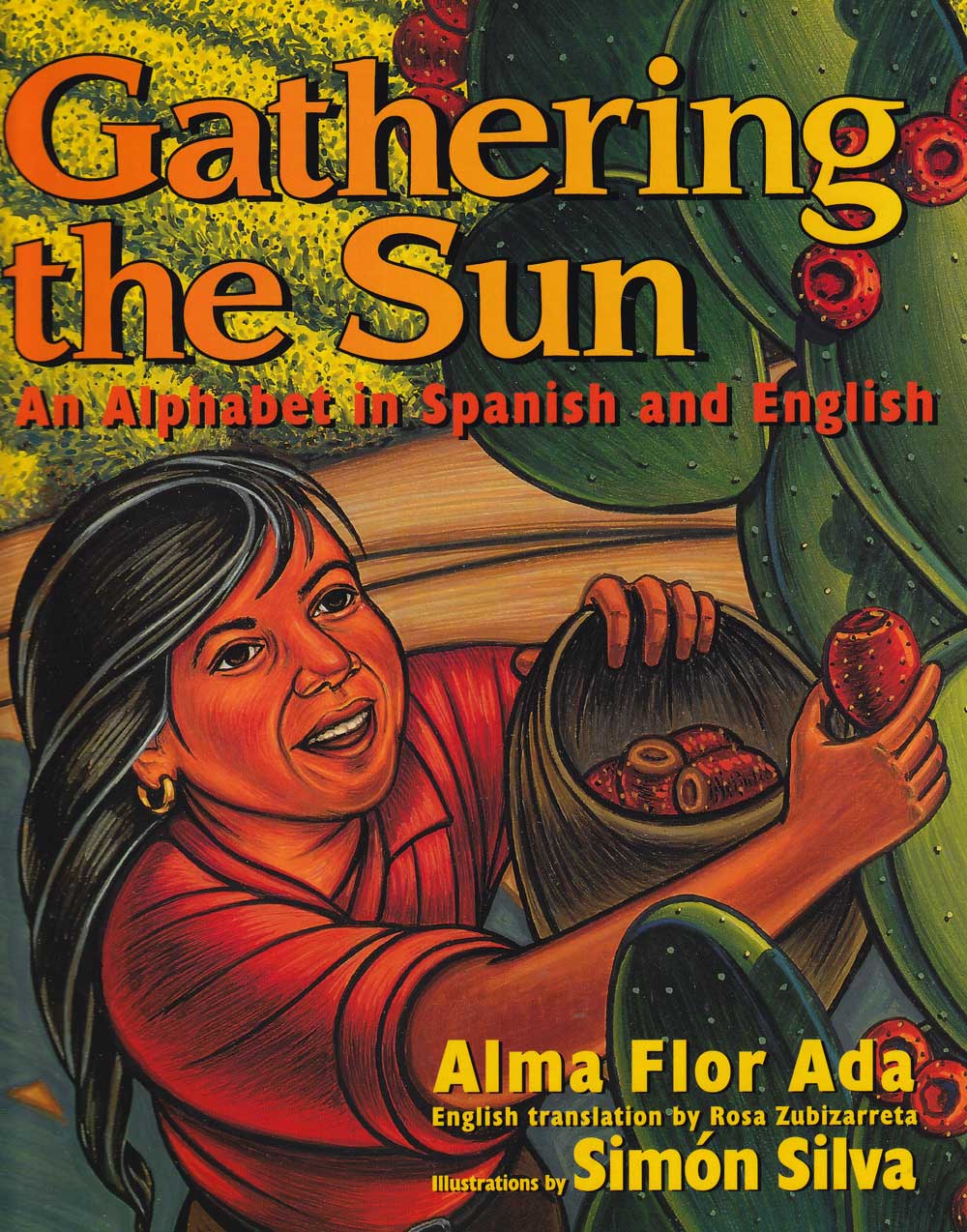 Gathering
the Sun
Gathering
the Sun
Pura Belpre Award
Honor Book in 1998 for Illustration
American Booksellers
Association, Pick of the List
California Reader's Collection, Elementary List
Center for Latin
American Studies, America´s Commended List
National Council of
Social Studies and the Children’s Book Council, Notable Book in the Area of
Social Studies
National Council of
Teachers of English, Notable Book in the Area of Language Arts
Simon
Weisenthal Center, Museum of Tolerance, Once
Upon a World Award
Gathering the Sun Hardcover is available at 20%-Off for $14.39, including Free Immediate Mailing and No Sales Tax : Gathering the Sun, Hardcover, Bilingual, Book, Alma Flor Ada, Simon Silva, Rosa Zubizarreta, Preschool and Up, 9780688139032, $17.99
The author’s many years of work with migrant families inspired this poetic ABC of the fields, and Simón Silva’s magnificent illustrations have created a work of art to be enjoyed by children and adults alike.
The bilingual poems
of Gathering the Sun are an homage to the farm workers lives and struggle.
Simón Silva, who knew intimately the life in the fields during his childhood
and has drawn from the heritage of the great Mexican muralists provided strong
and magnificent illustrations for the book that accompanies this CD. Suni
Paz unique voice and her masterful compositions have allowed the words in this
book to transcend their birth as poems becoming unforgettable songs.
Suni has drawn from her extensive
knowledge of Latin American folklore to create the inspirational music of these
memorable songs, an irresistible invitation to listen, to enjoy, to sing along.
Author's Note : Some of the most heartening experiences of my life have been my work with Migrant Farm Working families. I have described the academic results of sharing high quality children’s books with Migrant parents and inviting them to create books with their children in Pájaro Valley, California in the book A Magical Encounter : Use of Latino Literature in the Classroom. I have described my work with farm working parents, and the learning I derived from it, in my memoirs, Vivir en dos idiomas. The poems of Gathering the Sun were born out of these enriching experiences. Simón Silva, who knew intimately the life in the fields during his childhood and has drawn from the heritage of the great Mexican muralists provided strong and magnificent illustrations that have made this book the true homage to the farm workers lives and struggles that I dreamt to create. It has given me unsurpassable joy to sign this book for golden anniversaries of grandparents and for birthday gifts, for quinceañeras, new born babies and babies yet to be born, realizing that in each case the book is a symbol of the strength, the resilience, the determination, the dignity and the profound love of family of those who work in the fields and whose labor allows us all to live. Suni’s unique voice and her masterful compositions have allowed the words in this book to transcend their birth as poems becoming unforgettable songs. My gratitude to Suni and Simón, for allowing this homage to César Chávez and all campesinos to be as inspiring as his example and their lives.
Allison's Blog : Gathering the Sun: An Alphabet in Spanish and English by Alma Flor Ada is a collection of simple poems for children. There is a different poem for each letter of the Spanish alphabet depicting the lives of Latin Americans in various aspects. The poems are written in both Spanish and English. They are each short in length and are different from one another. They are mostly about migrant workers and they speak of things such as work in the fields, fruits and vegetables, stars in the sky, love, and leisurely activities. There are young boys and girls, men and women seen in the illustrations that depict the main ideas of each of the different poems. This book is both written and illustrated by insiders of the culture and is an excellent piece of authentic Latin American children's literature. The poems and pictures address migrant work realistically by depicting the physical labor and long hard hours without giving it a lack of admiration and respect. The poem titled "Thanks" is of a young girl giving thanks for all of the positive things she has in her life. The poem titled "Honor" is of a young boy speaking of the honorable work him and his family do in the fields. While the book portrays the migrant workers as having little on a material level, the poems titled "Thanks", "Pride", and "Honor" show that this did not affect their happiness. This is also reinforced through the illustrations where the characters are depicted with smiles on their faces, as content with their jobs, and as happy when they are together at the dinner table or sitting outside with their families. Another poem titled "Love" speaks of the strong bond and closeness between family members and extended family members. Pride of the Spanish language and Mexico are also themes in this piece of literature. These are all common values that are often held by members of this culture and therefore add to the books authenticity.
School Library Journal : PreSchool - Grade 5 An alphabet book with exceptional illustrations and excellent poetry that gives voice to the experience of Hispanic agricultural workers. Each letter is matched with a Spanish word (for example, "Arboles" for "A") and accompanied by a poem in both Spanish and English that describes how the plant, fruit, vegetable, person, or feeling functions in the lives of these workers. Zubizarreta's English translations are informed and graceful, but predictably cannot match the Spanish originals in rhythm, assonance, or meter. Silva's vibrant, double-page, gouache illustrations are reminiscent of the artwork of Diego Rivera and Jose Clemente Orozco. The colors are brilliant, and the scope has a certain larger-than-life sense to it. This is a book that begs to be read aloud to all students, whether they are Spanish speaking or not. The sound of the poems will draw them in. The touching elegy for Cesar Chavez successfully imparts the impact of a heroic man on his people. Whether used to show the plight of migrant workers or the pride Hispanic laborers feel in their heritage, this is an important book.
Booklist : Ages
5-8 Using the Spanish alphabet as a template, Ada has written 27 poems
that celebrate both the bounty of the harvest and the Mexican heritage of the
farmworkers and their families. The poems, presented in both Spanish and
English, are short and simple bursts of flavor: "Árboles/Trees,"
"Betabel/Beet," "César Chávez," etc. Silva's sun-drenched
gouache paintings are robust, with images sculpted in paint. Brimming with
respect and pride, the book, with its mythic vision of the migrant farm worker,
will add much to any unit on farming or Mexican American heritage.
Horn Book : "These brief poems honor the lives of migrant farmwokers
and celebrate an alphabetic list of spanish words."
Amazon : In simple words and sun-drenched paintings, Alma Flor Ada and Simón
Silva take us into the fields and orchards, and into the lives of the people who
work them. Simple poems in Spanish and English, one for each letter of the
Spanish alphabet, describe the wonder of the vegetable and fruit farms.
Together, the poems and the rich illustrations celebrate the glory of nature and
the hearts of all who dedicate their lives to working the land.
Google : Moving in its simplicity and candor, this collection of poems tells the story of Hispanic migrant farm workers and their deep connections to the earth they till. Each gentle poem begins with a letter of the Spanish alphabet and appears in both Spanish and English. Vibrant gouache paintings wash each page in color from dawn to twilight in a work that celebrates a people, a language, and the land. The American Library Association has named Gathering the Sun a Pura Belpre Honor Book for its portrayal, affirmation, and celebration of the Latino cultural experience in literature.
Listen to a sample song from Gathering the Sun's 27 songs by clicking on the highlighted CD title below.
27-Song Gathering the
Sun CD
A : Árboles
B : Betabel
C/Ch : César Chávez
D : Duraznos
E/F : Estrellas o flores?
G : Gracias
H : Honor
I : Isla
J : Jardin
K : Kiosco de cerezas
L : Lechuga
Ll : Lluvia
M : México
N : Nopalera
N : Niña campesina
O : Orgullo
P : Pájaro
Q : Querer
R : Regar
S : Surco
T : Tomates
U : Uno
V : Violetas
W : Farmworkers
X : Xochitl
Y : Yucaán
Z : Zanahoria
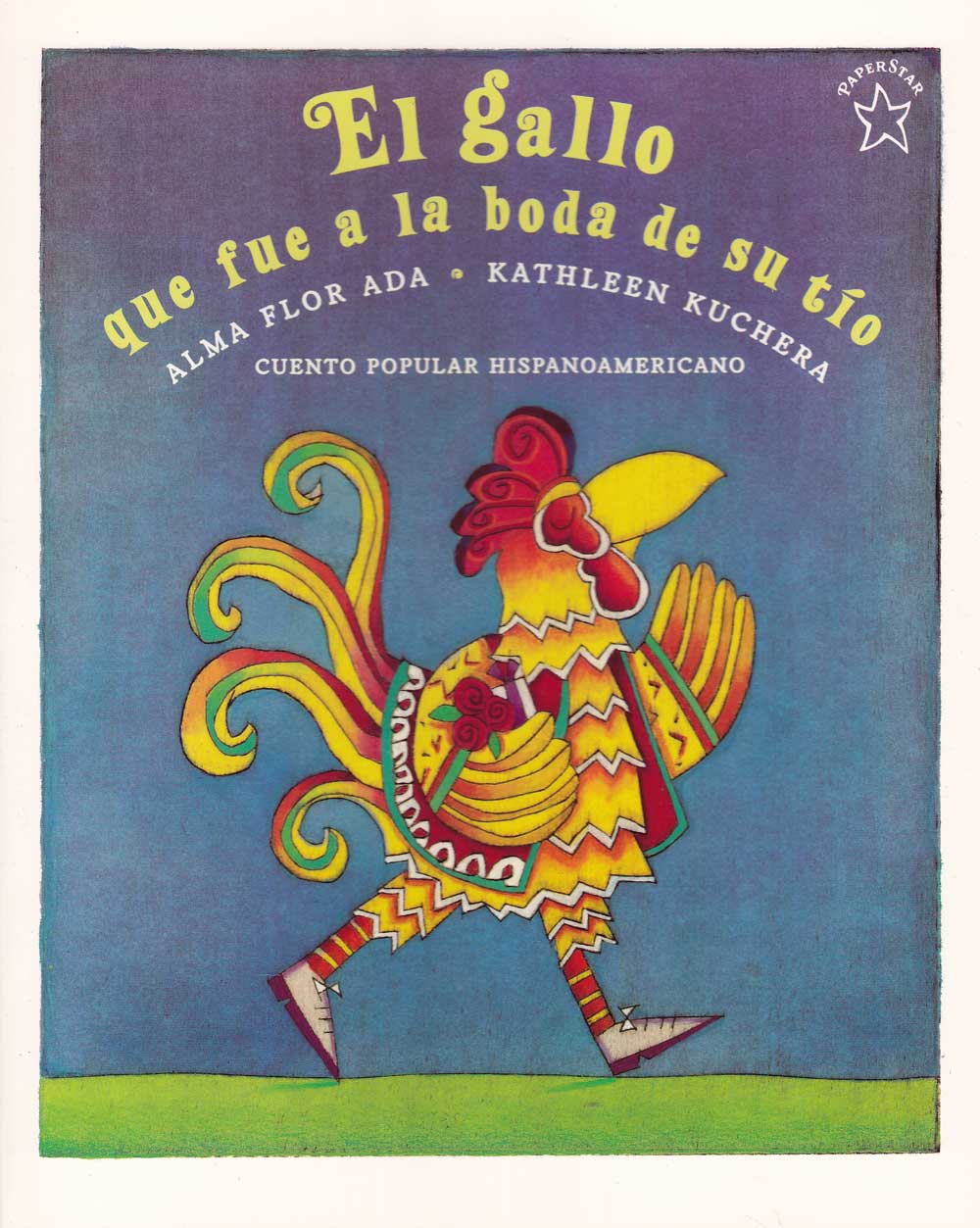 Gallo que fue a la boda de su tio
Gallo que fue a la boda de su tio
Rooster Who Went to His Uncles Wedding
American Booksellers Association, Pick of the List
Bank Street College, Best Books of the Year
What can you do if your beak is covered with mud, and the grass refuses to help you… the sheep won’t eat the grass,,, the dog won’t bite the sheep…? Well if you are a rooster on your way to your uncle’s wedding, you’ll ask your friend the sun, and he’ll surely turn things around! Outstanding illustrations by Kathleen Kuchera add brilliant Tropical colors to this sunny story.
“Like the talented storyteller who shares her version with us now,this enchanting cummulative tale has roots in many Spanish-speaking countries around the world, where it has found a delighted audience of children.”
(Tomie de Paola)
Author’s Note : This is one of the many tales which I received from my Grandmother, my mother’s mother, who was a fabulous storyteller. She would tell it to me outdoors, usually on the porch, and would weave into the story any of the animals we could see –a goat, a cow—and the story would change from day to day, becoming as alive as our own surroundings. In turn, I have enjoyed telling this story to children and seeing them delight as I tell it faster and faster, as the list of characters grow. It has also been fun to see children perform this story as a play.
Listen to Vienna Rose read The Rooster who Went to his Uncle's Wedding to you. A marvelous example of the magical encounter between a child and books that we wish for all children. And here's an
earlier reading by Vienna Rose, and an
even earlier
reading.
Booklist : “This delightful cumulative tale introduces a perfectly groomed rooster with a gleaming beak, who’s on his way to his uncle’s wedding. As hunger overcomes him, he ponders, “Peck or not peck?” while looking at “a single golden kernel of corn” lying in a puddle of mud. Peck he does, and he muddies his beak as he gobbles the kernel down. Now, how to get his beak clean? The velvety grass won’t do it, but the rooster thinks perhaps he can scare the grass into helping, if he asks the lamb to eat the grass. The list of characters who refuse to help is long. Finally, the rooster’s good friend, the Sun, comes to his rescue. Each character, when threatened by a natural adversary, does what it is supposed to do, which in the end, helps the rooster. The rooster, a universal folk character humanized in many cultures, is appealing here. The story which was told to Ada by her grandmother in Cuba will delight young children with the sheer joy of its repetitive rhythms, and it is particularly appropriate to be told aloud. The illustrations, bright with tropical colors, depict a Latin American setting. The strongest element of this Latin American folktales is the universality of its theme, which makes it an interesting addition to the folktale collection for preschoolers.”
Publisher’s Weekly : The author of The Gold Coin retells a Latin American version of a familiar cumulative folk story illustrated in the vibrant colors of the tropics. In a narrative line reminiscent of Rosanne Littzinger's The Old Woman and Her Pig, Ada tells of a rooster who muddles his beak en route to his uncle’s wedding feast; […] Through harmonious repetition and singsong rhythms, Ada’s leisurely, conversational tale neatly mimics the cadences of a Traditional storyteller. Kuchera’s (Your Skin and Mine) geometric illustrations in intense hues of orange and chartreuse evoke the designs of Latin American folk art with their flat edges, sharp lines, zigzags and whorls. […] The artist deserves kudos for her animated rendering of such normally static objects as a stick and a blade of grass.”
School Library Journal : PreSchool-K-- Rooster, en route to his uncle's wedding, struggles with the dilemma of whether he should risk of getting dirty in order to obtain a kernel of corn. His hunger overcomes his better judgment and, of course, he winds up ". . . with a beak full of mud." This leads into a cumulative tale that will be familiar to anyone who knows "The Old Woman and Her Pig" or any number of its variants. In this case, his quest to get clean is nicely circular: the sun, just coming up as the book begins, is the one who agrees to break the chain of refusal, to repay the rooster for greeting him each morning. Ada's lively adaptation uses economical language with just enough detail to move things along. Vivid hand-colored prints illustrate the story well. All of the characters are festively arrayed: the blades of grass, for example, play musical instruments, and one is wearing a gaucho hat and a cape. The sheep wears a ruffled dress and has a bowl of fruit on her head, a la Carmen Miranda. The plain white borders contribute to the clean pleasing design. The stylized patterns, with lots of diamonds and zigzags, have the look of Central and South American folk art. A solid addition to folklore collections and a story hour hit as well.
Kirkus Reviews : A cumulative tale that echoes ``The Old Woman and Her Pig.'' Since the debonair rooster is so busy preening his feathers and polishing his beak that he skips breakfast, the kernel of corn he finds on his way to the wedding is tempting, though it's in a puddle. Seizing it, he muddies his shiny beak, and the trouble begins. The grass refuses to clean the beak; the dog won't bite the lamb that won't eat the grass--and so on, until the sun, grateful for the rooster's daily song, starts to dry out the water, which starts to put out the fire.... This Latin American variant is gentler than the familiar tale, but just as lively. Kuchera's decorative illustrations, with whimsical personifications (especially of the grass, fire, and water) and the elegantly stylized rooster in lemon, emerald, and flame against a brilliant blue sky, are splendid. An unusually appealing
readaloud.
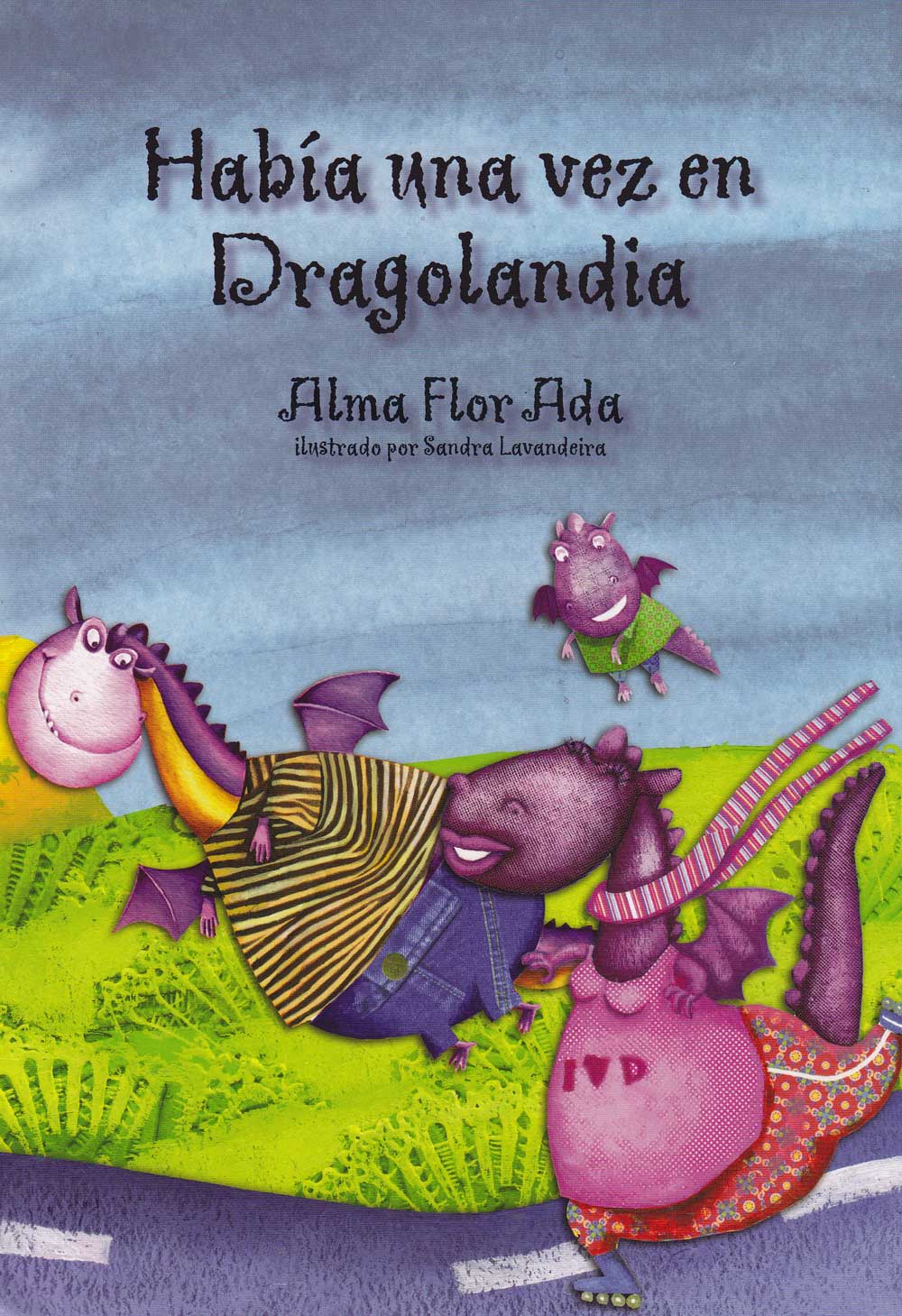 Habia
una vez en Dragolandia
Habia
una vez en Dragolandia
Alma Flor Ada’s fanciful tale of a dragon family ends with an explanation of the origin of lightning and thunder. Enjoy visiting Dragon Land!
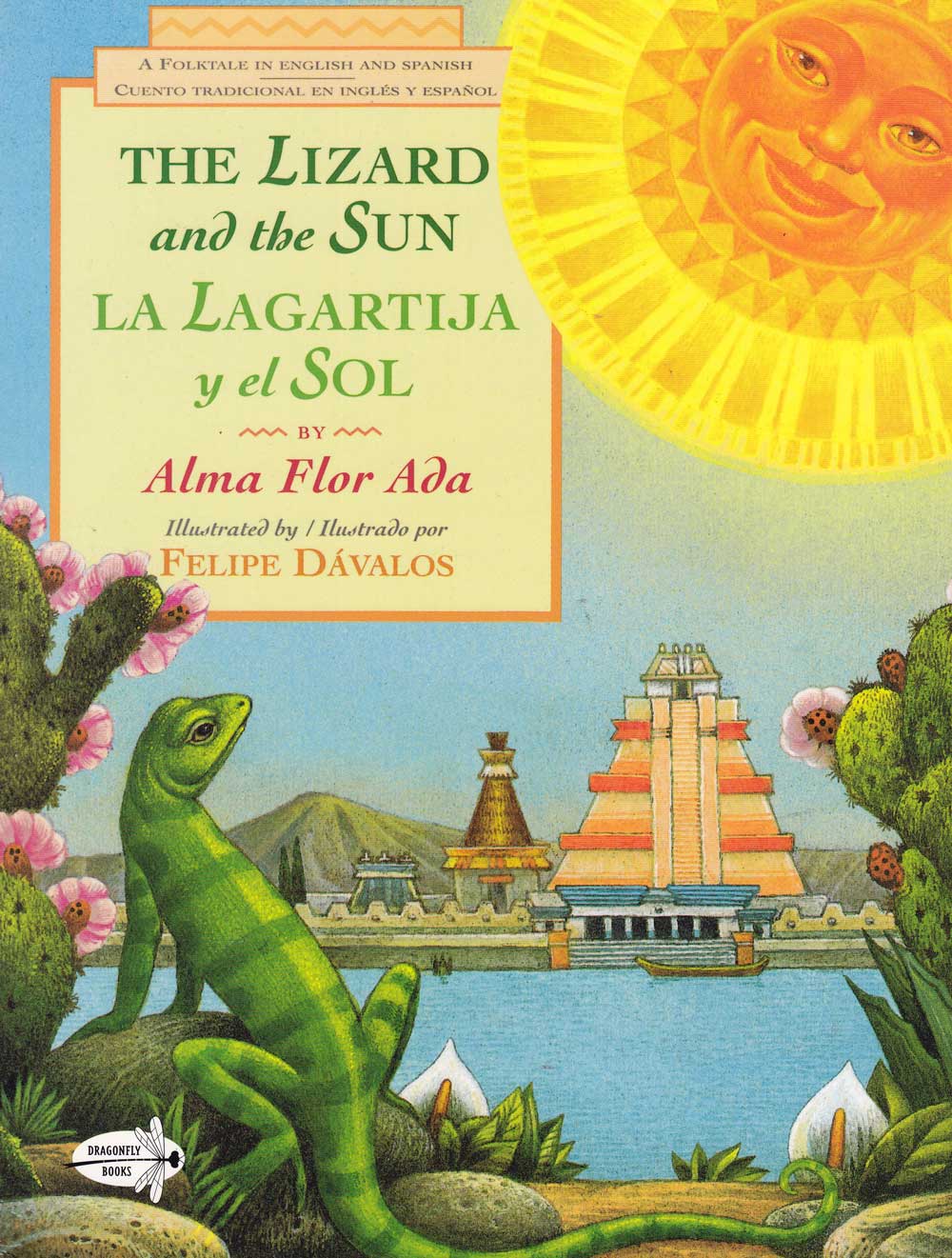 La lagartija y el sol - The Lizard and the Sun
La lagartija y el sol - The Lizard and the Sun
ASSOCIATION OF PARENTING MAGAZINES GOLD MEDAL
Once, a long, long time ago, the sun disappeared from the sky. Everything was dark for many days. All the animals went to search for the sun in the rivers and lakes, through the fields and forests, but the sun was nowhere to be found. Little by little all the animals gave up, except for the faithful lizard. Finally one day she found a strange glowing rock and discovered the sun fast asleep. But no one could persuade the sun to wake up. Then the emperor organized a great feast, with the finest dancers and musicians, so the sun would wake up and never fall asleep again. Since that day, all lizards love to lie in the sun, to remember the day when one of their own brought light and warmth back to the world.
Author’s Note : What a gift to have had Felipe Dávalos create the art for this story. Felipe Dávalos is a great artist and also a learned scholar. As an archaeologist he knows a great deal about the time and setting of this story. And his wonderful illustrations reflect his art and his knowledge.
Reviews : School Library Journal : Kindergarten-Grade
3. A bilingual (English/Spanish) retelling of a Mexican folktale. When the sun
does not appear for several days in a row, everyone becomes anxious. Various
animals set off to look for it in such places as rivers, lakes, the jungle, and
even in the cone of a volcano. After searching high and low, they give up,
except for Lizard. Her faith and perseverance is rewarded when the celestial
body is found sleeping under a rock. The story emphasizes the importance of the
sun to all living creatures. The colorful double-page illustrations evoke the
native culture by featuring characters in their decorated tunics and
headdresses. In addition, the use of musical instruments such as drums
reinforces Indian culture. Readers will cheer Lizard as she finds the Earth's
source of light and warmth. An excellent choice for storyhours.
Kirkus Reviews : Ada elongates a Mexican
folktale about a tenacious lizard who won't stop looking for the sun when it
disappears; Davalos creates a series of half-lit, blue-toned spreads that evoke
the world of the Aztec empire. A first-person introduction explains natural
absences of the sun (behind the clouds, etc.), and prepares readers for a time,
long ago, when the sun disappeared for no reason. Animals and birds search for
it, and fail; only the lizard continues, finding a strangely glowing rock and
rushing off to the city to tell the emperor. He tells her to move the rock,
which she attempts, but the rock won't budge--once more, she's off to the city.
The emperor comes to the rock with a woodpecker, and its beak splits the rock
open, revealing a sleeping sun, who drowsily agrees to return to the sky if the
emperor will provide the liveliest musicians and dancers. So the entertainment
is arranged, and all ends well, with the inauguration of an annual feast.
English and Spanish texts appear on each spread of this pleasant tale, diluted
only by the several journeys of the lizard between rock and city, and the sun's
prolonged resistance to waking up. (Picture book/folklore. 5-8).
"Once in ancient Mexico, the sun disappeared. For days the anxious people wait for the sun to return, but it does not. When lizard discovers a rock lowing with an inner light, she tells the emperor and they awaken the sleeping sun; it returns to the sky, shedding light and warmth on all the earth. Ada retells this traditional tale with graceful language and read aloud rhythms, juxtaposing images of the tenacious, questing lizard against the darkness of jungle, marketplace, and palace. Dávalos paintings are rich with color and expression as the bright green lizard traverses the torchlit night in balanced compositions that spring to bright life with the discovery of the brilliant, sleeping sun. […]” (The Bulletin for the Center of Children’s books. October, 1997)
“[…] The Cuban-born author says she hopes the dual-language format will help awaken children’s interest in acquiring a second language, and certainly it should arouse their curiosity. Artist Felipe Dávalos, originally from Mexico, has created a colorful, exotic landscape full of pyramids, cacti and ancient Mexican sculpture and design. His illustrations beautifully capture the glowing changes as the sun shines once more. “The Lizard and the Sun” is a sumptuous introduction to the land of the Aztec and Maya.” (Bookpage. October, 1997)
“[. . .] Felipe Dávalos’s stylized double-page illustrations complement the bilingual text handsomely. Cross-hatching and speckled backgrounds add shading and texture to artfully arranged compositions that echo the city’s pyramid shapes.” (Reading Teacher, September 1998)
“ A bilingual (English/Spanish) retelling of a Mexican folktale. When the sun does not appear for several days in a row, everyone becomes anxious. Various animals set off to look for it in such places as rivers, lakes, the jungle, and even in the cone of a volcano. After searching high and low, they give up, except for Lizard. Her faith and perseverance is rewarded when the celestial body is found sleeping under a rock. The story emphasizes the importance of the sun to all living creatures. The colorful double-page illustrations evoke the native culture by featuring characters in their decorated tunics and headdresses. In addition, the use of musical instruments such as drums reinforces Indian culture. Readers will cheer Lizard as she finds the earth’s source of light and warmth. An excellent choice for story hours.” (Vanesa Rivas, NYPL, School Library Journal, August, 1997)
“Presented in both Spanish and English, this gentle traditional tale from Mexico shows how people working together can get the job done. When the sun disappears from the sky it is lizard who discovers “a rock that is shining as though it had a light inside.” Traveling to the distant city she tells the emperor who orders her to move it. But when is unable to, the emperor and the woodpecker help lizard release the reluctant sun trapped inside. The structure is different from many folktales, allowing more room for Ada’s eloquent voice. Dávalos sets the story during the time of the Aztec empire; his stylistically detailed artwork is initially veiled in midnight blue but erupts in golden yellow when the sun finally returns to the sky. According to the author’s note, Ada remembers this pourquoi story from an old reading text.” (Julie Corsaro, Booklist, December, 1997).
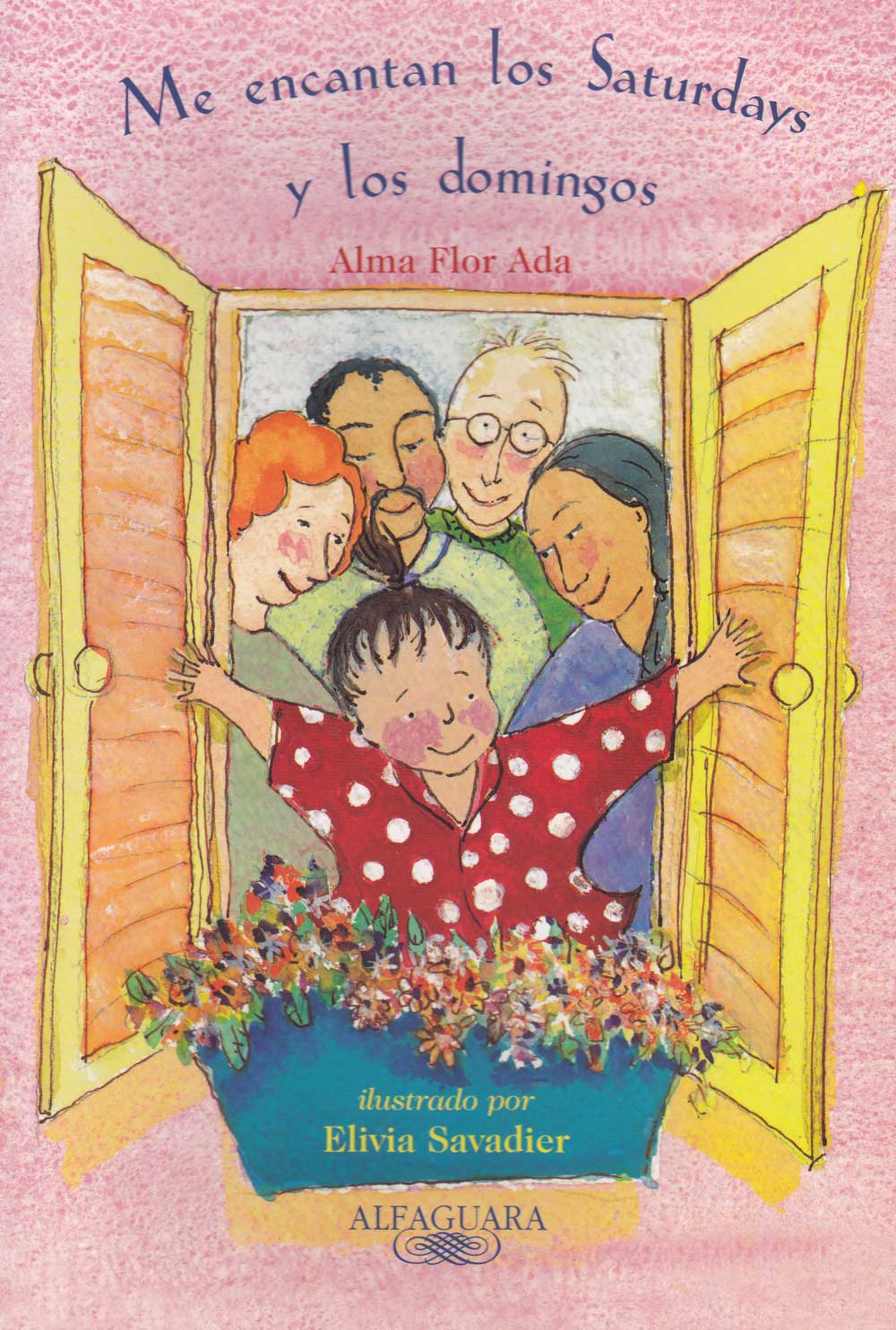 Me
encantan los Saturdays y los domingos
Me
encantan los Saturdays y los domingos
I Love Saturdays y domingos
Center for Latin American Studies, America´s Commended List
Saturdays and Sundays are very special days for the child in this story. On Saturdays, she visits Grandma and Grandpa, who come from a European-American background, and on Sundays -- los domingos -- she visits Abuelito y Abuelita, who are Mexican-American. While the two sets of grandparents are different in many ways, they also have a great deal in common -- in particular, their love for their granddaughter. While we follow our narrator to the circus and the pier, share stories from her grandparents' pasts, and celebrate her birthday, the depth and joy of both cultures are conveyed in Spanish and English. This affirmation of both heritages will speak to all children who want to know more about their own families and ethnic backgrounds.
Author's Note : This book is very dear to me for the great reception it has received from readers. Many times during autographing sessions people tell me they want it for a special child with dual heritage, and it not only for those that share Hispanic heritage, but many others as well. While many people think I must have been inspired by my own family–two of my sons are married to women of Anglo descent and the third to a Brazilian, the idea for the book came to me, a long time ago, before any of my children had married. While in Hawaii, a Sunday afternoon in Lahaina. I watched as many families strolled by. It was apparent that they had very mixed heritage–Chinese, Japanese, Filipino, Hawaiian, Puerto Rican, Anglo– and that they felt very comfortable with each other. That experience moved me to write this story. It took a long time for the book to be published and by then I did have grandchildren with dual heritage. Some times in my own experiences I wonder whether literature reflects life or life reflects literature. Seeing this book transformed into a video has been wonderful. It made it even more interesting to be interviewed for the video in the company of my granddaughter Camille.
Watch or Listen to Vienna Rose read I Love Saturdays y domingos to you. A marvelous example of the magical encounter between a child and books that we wish for all children.
Sara Hale :
This book is an example of multicultural or international literature. It is
about a little girl who spends the weekends visiting her grandparents. Her
grandparent’s on her father’s side of the family speak English, and her
grandparents on her mother’s side of the family speak Spanish. The book has
alternating pages that go back and forth between her experiences with each set
of grandparents. When describing her Hispanic grandparents, some of the words
are written in Spanish. Even though they come from different backgrounds, both
sets of grandparents are very similar and plan the same activities for their
granddaughter, such as cooking breakfast, playing with pets, counting things,
learning about the circus, looking at fish, etc. At the end, the girl’s
whole family gets together to plan a special birthday surprise for the little
girl. The Hispanic culture is represented by the words written in Spanish and
by some of the activities described, such as playing with piñatas and singing
“Las mañanitas,” a popular Spanish song, on her birthday.
This book would be great for any classroom to teach children about the Spanish
culture and also to show children that people from different backgrounds are
alike and enjoy similar activities! Children can also connect to the book if
they have ever spent a weekend with their grandparents. The book is especially
great for classes that have Spanish-speaking students. I read this book to a
second grade class last semester, and the whole class loved it. The
Spanish-speaking children seemed very excited to be hearing a book with some
Spanish words! They even sang the song, “Las mañanitas” for me, because I
did not know the tune. I think that 3rd-5th graders would love this book as
well, especially readers who are a bit behind grade level or students who are
still learning English. The pages basically say the same thing in English and
then again in a combination of English and Spanish, so this could help them
learn the language by seeing direct translations and connections!
Hilary Lemar : Award winning author, Alma Flor Ada, who also wrote My Name is Maria Isabel, has done an amazing job celebrating differences in culture in I Love Saturdays y domingos. This story starts off with a little girl telling about her weekends with her grandparents. She spends Saturdays with her father’s parents and domingos with her mother’s parents. She tells about what each grandmother serves her for breakfast. Her father’s mom gives her milk, scrambled eggs, and pancakes, while her mother’s mom gives her huevos rancheros. The little girl expresses her love for the differences in her grandparents’ cultures and speaks proudly of each grandparent and where they came from. This story shows how important a person’s culture is to themselves, as well as to the rest of their family. When this little girl grows up she will tell of these many different cultures that are all an important part of who she is. I think that this story is important to have in the classroom and would be great to do as a read aloud. I think that students would benefit greatly to read or have this book read to them because it will teach them that there are many different cultures and that people should be proud of their culture and who they are. I really feel like Alma Flor Ada does a wonderful job sending a positive message to be proud of and to celebrate you culture. Children will benefit from hearing this message and hopefully they will remember it in the future.
Carmen : Discussion: It is important for students to be able to compare and contrast different things. Through writing a compare/contrast paper students are able to see the similarities and differences between different things. Then it is possible for them to come to a conclusion about possibly making a decision. In the book I Love Saturdays y Domingos by Alma Flor Ada a bilingual girl compares the different activities and personal qualities that she enjoys with each of her two sets of grandparents. Though she does different activities with each set of grandparents, she loves them each the same. How to Teach It: I am going to read a book titled I Love Saturdays y Domingos by Alma Flor Ada. It is about a bilingual girl who has two sets of grandparents that are very different, but she loves them each the same. Listen for the similarities and differences that her two sets of grandparents have. In the story she calls one set of grandparents “Grandma and Grandpa” and her other set of grandparents “Abuelita and Abuelito”. Abuelita is the Spanish word for grandma and Abuelito is the Spanish word for grandpa. I’m going to have a list of the similarities and another list of the differences between the girl’s grandparents. Can anyone name any similarities between the girl’s grandparents? Ex: Both grandfathers like to tell stories about when they were growing up. Both grandmothers like to tell stories about their families when they were young. (I would write the similarities as a list on the board) Can you name any differences? Ex: Her Grandma has a cat, and her Abuelita has a dog. She watches movies about the circus with her Grandma and Grandpa. She goes to the circus with her Abuelita and Abuelito. (I would write the differences as a separate list on the board) Now that we know what a story is like that compares and contrasts different things or people, I want you to try and write your own comparing and contrasting story. You can compare/contrast anything you want. You can compare and contrast the activities and personal traits of your own grandparents like the girl in the book did, or you can pick two totally different things or people to compare and contrast. You might even try comparing two different options for a decision you are trying to make. To start off you might want to make a list of the similarities and then a list of differences so you can have a starting point for your story.
Alma Flor Ada : Dear Carmen: I was just delighted to read your suggestions for the presentation of my book I Love Saturdays y domingos. This book is very dear to me for the great reception it has received from readers. Many times during autographing sessions people tell me they want it for a special child with dual heritage, and it not only for those that share Hispanic heritage, but many other also. Since you like the book I'd tell you a little about its origin: While many people think I must have been inspired by my own family --two of my sons are married to women of Anglo descent, one to a Brazilian, the idea for the book came to me, a long time ago, before any of my children had married. While in Hawaii, a Sunday afternoon in Lahaina I watched many families strolled by. It was apparent that they had very mixed heritage --Chinese, Japanese, Filipino, Hawaiian, Puerto Rican, Anglo-- and yet they felt so comfortable among each other. It took a long time for the book to be published and by them I did have grandchildren with dual heritage. Again, thanks for sharing your ideas for this book and for being so enthusiastic about the work you do. With all best wishes, cordially, Alma Flor Ada
Publishers
Weekly : Through this affectionate and revealing portrait of a bilingual girl's
weekend visits to her two sets of grandparents, Ada (Where the Flame Trees
Bloom) and Savadier (A Bedtime Story) prove that straddling two worlds can be a
blessing rather than a hardship. The left of each spread depicts the narrator
spending Saturdays with her paternal grandparents, with whom she speaks English;
on the right, she passes los domingos (Sundays) with her Mexican-American
Abuelito and Abuelita and converses in Spanish. The situations in the two
households share enough similarities that readers can extrapolate the meaning of
the Spanish words in context. For instance, on one spread, the colors of the
balloons her paternal grandparents give her also appear in the kite that her
Abuelito makes for her. Each pairing makes for a loving comparison and contrast,
enlivened by Savadier's graceful, warm-toned watercolor spot illustrations. At
book's end, both sets of grandparents coordinate a cooperative gift for the
girl's birthday. The balance tips slightly in Abuelito and Abuelita's favor, in
terms of fun and exoticism (e.g., Grandpa and Grandma watch a video about the
circus while the Mexican-American grandparents "take me to a real
circus"). Youngsters, however, will come away with the idea that this girl
is very lucky to have four such interesting people who love her. Ages 4-8.
School Library Journal : K-Gr 2-A little girl recounts the joy of her weekends,
Saturdays spent with her Euro-American Grandma and Grandpa and Sundays (los
domingos) with Abuelito and Abuelita, her Mexican-American grandparents. She
does different things in each place and goes on different outings: off to the
circus, to the pier, out floating balloons or flying kites. She hears different
stories that reflect her grandparents' heritages. However, on her birthday, it
is clear that both sets of relatives are united in their love of their
granddaughter. Lively, childlike prose that integrates Spanish words flawlessly
and understandably makes this a winner for storytimes. Savadier's watercolor
cartoon illustrations are bright, clear, and stylistically reminiscent of
Lillian Hoban's work. Paired with books like Carmen Santiago Nodar's Abuelita's
Paradise (Albert Whitman, 1992), or even such old standbys as Helen Buckley's
Grandfather and I (Lothrop, 1994), this book will make a strong statement about
cultural diversity and the universality of love.
Booklist : Ages 4-8. A little girl visits her Grandpa and Grandma, her father's
parents, on Saturdays and her "abuelito y abuelita," her mother's
parents, on "los domingos." Dearly cherished by both sets of
grandparents, the little girl delights in the unique differences of the two
households and moves with ease between the two cultures. Although the little
girl uses Spanish words and phrases in describing her Sundays with her Mexican
American grandparents, for the most part the meanings are explained or can be
inferred from the context. Showing the various weekend experiences, Savadier's
softly colored watercolor illustrations reflect the happy heart of the little
girl. Together, Ada and Savadier have created a picture book that gracefully
embraces and celebrates a young child's involvement in her dual heritages.
Especially recommended for libraries serving Latino and multicultural
communities.
Mrs Lawrence : In one of her most popular works, Ada tells of a young girl enjoying the similarities and the differences between her English-speaking and Spanish-speaking grandparents. On Saturdays she goes to visit her father’s parents, Grandma and Grandpa. On Sundays she spends the day with her mother’s parents, Abuelito y Abuelita. She eats different breakfasts with each grandparent. Grandma has a cat named Taffy. Abuelita has a dog named Canelo. The young girl spends her weekend doing various activities with both sets of grandparents. It’s time to celebrate her birthday. She gets a new doll from Grandma and Grandpa and a dress. Her Abuelito has made her a dollhouse and Abuelita has made her a dress. The dress is the same as her doll. The kids take turn breaking the piñata. Her family celebrates by singing Happy Birthday and Las Mananitas. This multicultural story is warm and soft just like Elivia Savadier’s watercolor illustrations. Other titles by Ada are Dear Peter Rabbit, With Love, Little Red Hen, Three Golden Oranges, Yours Truly Goldilocks, and The Golden Coin. She received the Pura Belpre medal for her book Under the Royal Palms: A Childhood in Cuba. I thought this book was an excellent choice to teaching multicultural education. It really does include the beauty of diversity and the warm feeling of togetherness. This book is definitely a thumbs up, especially in the diversity category. An excellent way to help others understand the uniqueness of multicultural families.
Mrs Moore : I Love Saturdays y domingos by Alma Flor Ada: Award winning Alma Flor Ada (With Love, Little Red Hen) demonstrates the differences between two cultures in this book and how no matter what the differences, love is universal. A young girl encounters different experiences with two sets of grandparents during her weekend visits with them. One set of grandparents is English speaking while the other set speaks Spanish. The girl takes pleasure in how her grandparents are different in many ways, yet they have many things in common. One grandfather tells the girl stories about coming from Europe while abuelito tells stories about Mexico. Another difference is that the English-speaking grandparents make the girl pancakes for breakfast while the Spanish-speaking grandparents make juevos rancheros. The illustrations portray the joy and the love that family members share with each other. Elivia Savadier’s bright watercolor illustrations wonderfully capture the main thing that both sets of grandparents share in common in this story, which is their love for their granddaughter. This is a fabulous book that can be used to demonstrate the variety of cultures.. It could also be used to show that although there may be differences between cultures, people can all come together in love. I truly enjoyed this book especially because I can relate to it. My children have one set of grandparents that are English speaking and a set who speak English and Spanish. The two sets of grandparents share several differences and similarities. But one thing that they definitely share in common is that both sets love my children. As my son says, “I love Nana, Tata, Gigi and Papa and they love me.” Mrs Moore : Target Audience: 2nd Grade, Discussion: This book is a great book to use to demonstrate the differences between cultures and heritages. It can be used to teach about the many ways birthdays can be celebrated among different cultures. In a class with much diversity, children will get to know more about their classmates. Children will get a better understanding about other cultures and gain knowledge of the difference in celebrations among various people. How to Teach It: Today I will be reading the book I love Saturday y domingos. Okay class, now that we have read this book, what were some of the differences between the two cultures in the book? In what ways were both sets of grandparents different? Did they share anything in common? What did you think about how they celebrated the girl’s birthday? How does your family celebrate birthdays? Do you know of birthday traditions from other cultures? Now we will be writing about your own family birthday traditions and compare it to a birthday tradition of another culture. (Allow students some time to research other cultures in the school library as well as in the computer lab.) Now that we have written our papers, who would like to share what they have written first?
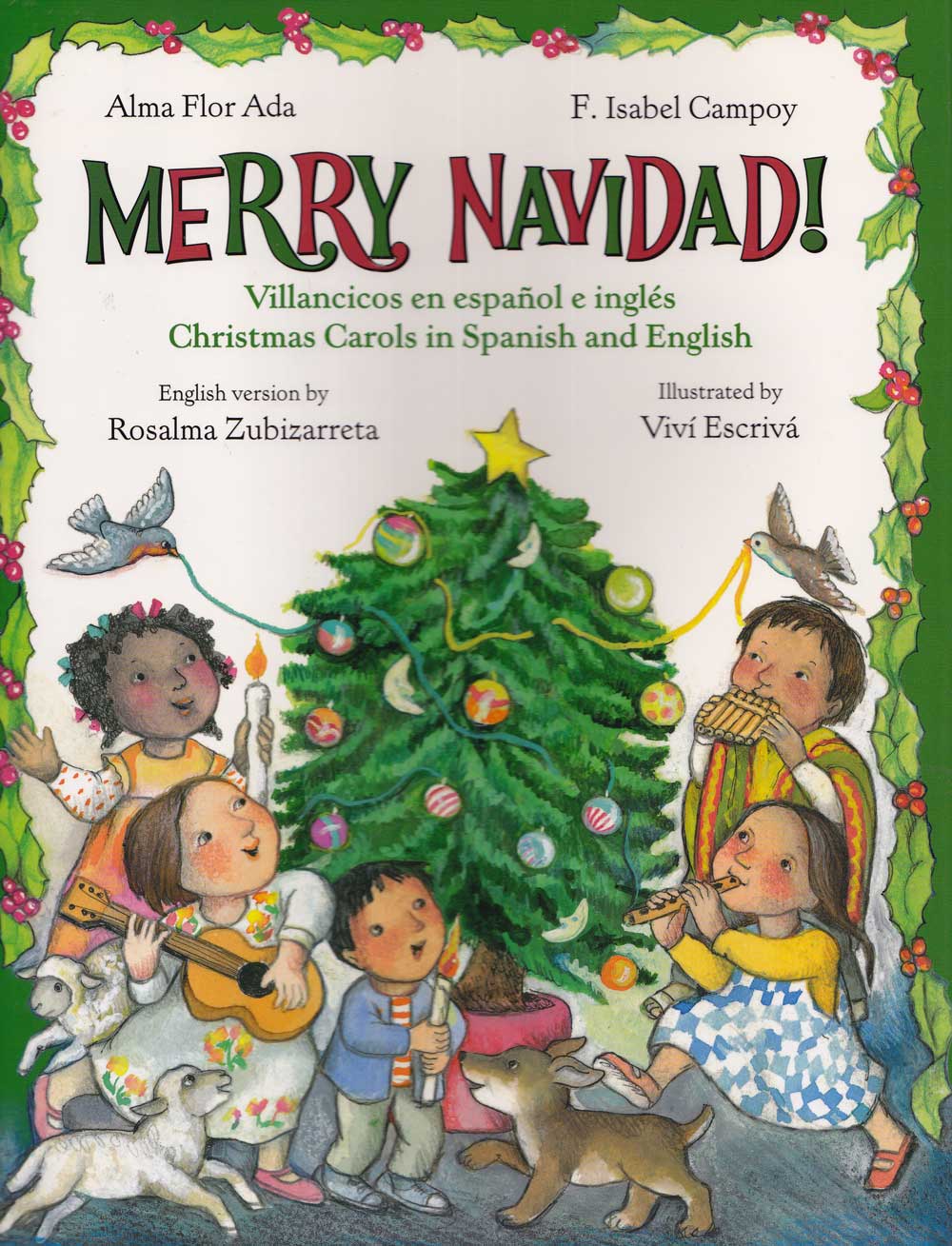 Merry
Navidad
Merry
Navidad
Resuenen con alegría
los cánticos de mi tierra
que viva el Niño Jesús
que ha nacido en Nochebuena.It's time to sing out with joy
the songs that are sung in my land
in praise of the precious Child
born this holy Christmas evening.
Come share the joy of a Hispanic Christmas!
In this warm and vibrant collection of traditional Spanish Christmas carols, or villancicos, noted authors Alma Flor Ada and F. Isabel Campoy bring to life the holiday traditions of Latin America and Spain. The creative English adaptations by Rosalma Zubizarreta both capture the spirit of the originals and add a new dimension to the songs. And Spanish illustrator Viví Escrivá's spirited illustrations are perfect backdrops for the lyrics, adding rich holiday flavor.
Come sing along! ¡Feliz Navidad! and Merry Christmas!
Google : Resuenen con alegría los cánticos de mi tierra que viva el Niño Jesús que ha nacido en Nochebuena. It's time to sing out with joy the songs that are sung in my land in praise of the precious Child born this holy Christmas evening. Come share the joy of a Hispanic Christmas! In this warm and vibrant collection of traditional Spanish Christmas carols, or villancicos, noted authors Alma Flor Ada and F. Isabel Campoy bring to life the holiday traditions of Latin America and Spain. The creative English adaptations by Rosalma Zubizarreta both capture the spirit of the originals and add a new dimension to the songs. And Spanish illustrator Viví Escrivá's spirited illustrations are perfect backdrops for the lyrics, adding rich holiday flavor. Come sing along! ¡Feliz Navidad! and Merry Christmas!
Blog
: Merry Navidad!
is a lovely idea and should be fun for families with children ages 5-10. This
is not a series of Spanish translations of well-known English-language carols
– it is more the other way around. Here are carols from Mexico,
Argentina, Spain, Chile and other Spanish-speaking countries, most of them
emerging from rural traditions that are fading but that retain long-lasting
charm. These villancicos are offered in Spanish and English
on facing or following pages, and arranged into such sections as “The Road to
Bethlehem,” “Christmas Eve” and “Christmas Lullabies.” Each
section is introduced – again, in Spanish and English – by a page explaining
the traditions of the Spanish-speaking world and the ways in which the villancicos
reflect those traditions. The words, by and large, are simple ones:
“
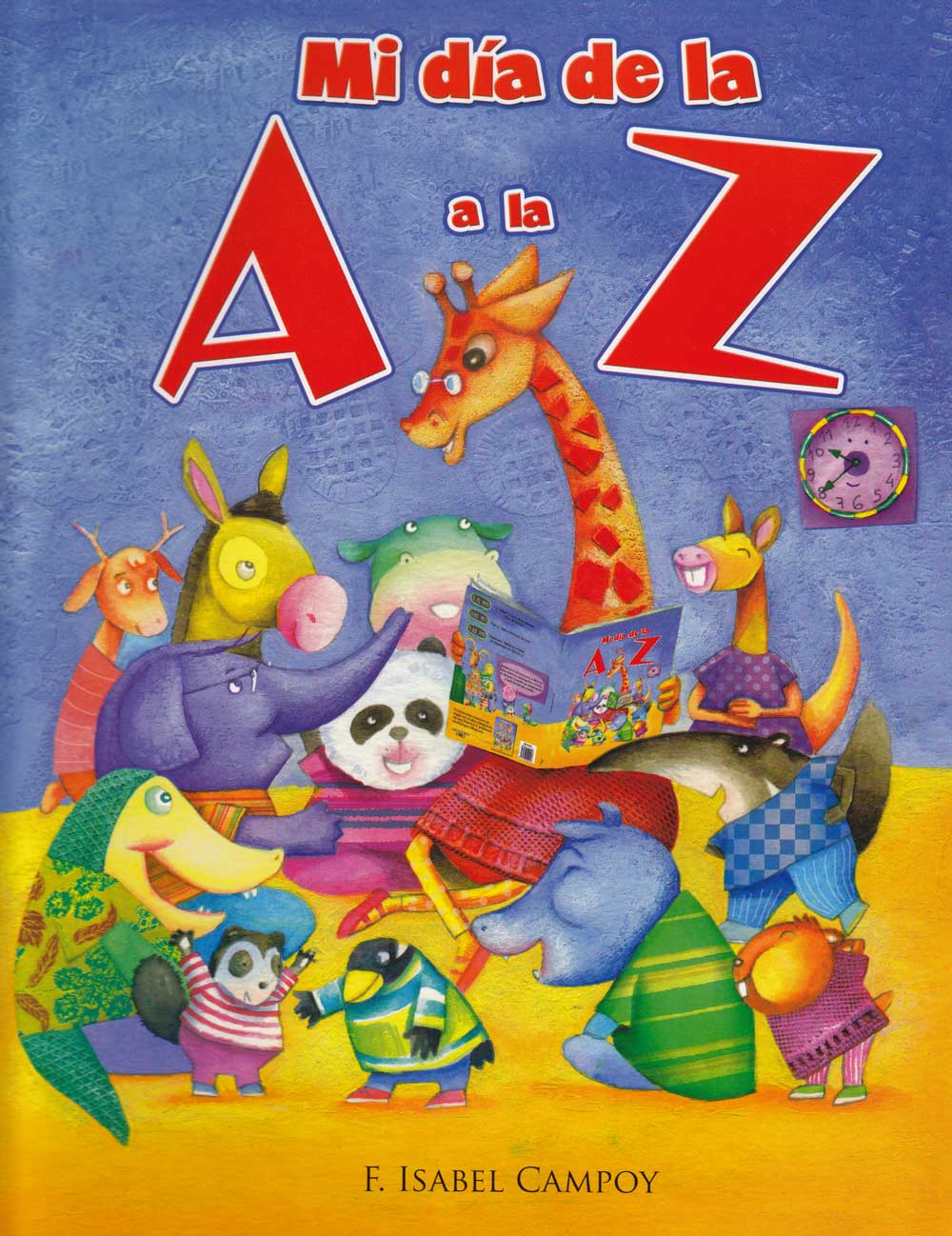 Mi
Dia de A a la Z
Mi
Dia de A a la Z
My Day from A to Z
An enchanting illustrated ABC book about a child's daily activities at home and school that can also be used to learn and practice telling time.
School Library Journal : PreSchool-Gr-2-In this charming story, a young elephant tells how he spends his day, taking children through the alphabet and teaching them to tell time as they enjoy his amusing adventures. The elephant wakes up at 7:15 a.m. and starts his daily routines with an Arriba to get ready for school. Each page features a gorgeous illustration, accompanied by a digital and an analog clock, a letter of the alphabet, a corresponding word, and a simple sentence. Readers see the elephant at home, at school, in the park, and at the supermarket before he returns home with his mother. His father gives him a present: a book about a unicorn; and at 8:19 p.m., when he is ready for bed, he asks his parents to read it to him. Campoy's exceptional command of the Spanish prose, Lavandeira's dazzling illustrations, the book's large format, and the variety of themes covered make this a unique title that offers multiple storytelling possibilities for teachers, librarians, parents, and caregivers.
Listen to Vienna Rose read My Day from A to Z to you. A marvelous example of the magical encounter between a child and books that we wish for all children.
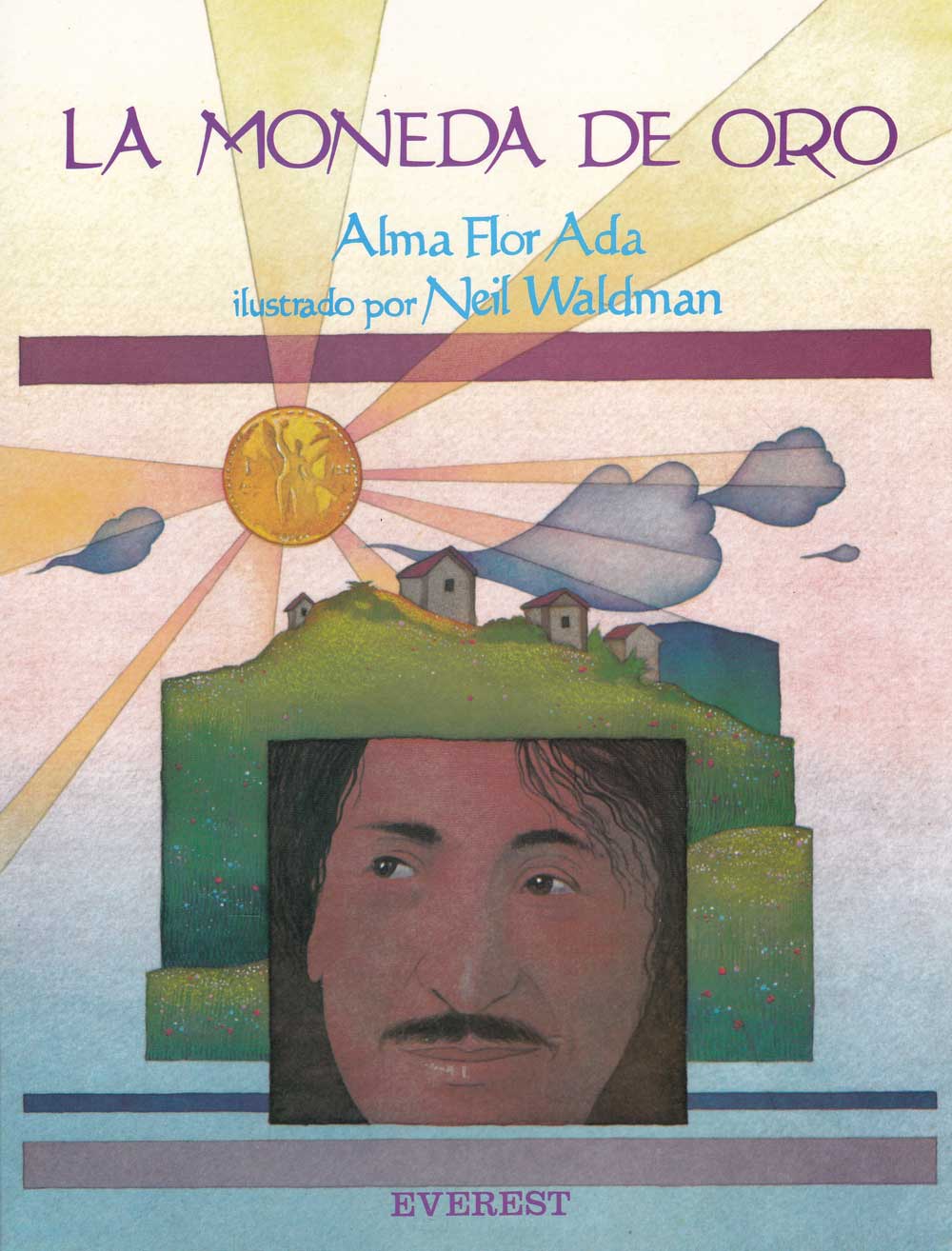 Moneda
de oro
Moneda
de oro
Gold Coin
American Booksellers
Association, Pick of the List
Center for Latin American Studies, America´s Commended List
Christopher Award Medal
National Council of Social Studies and the Children’s Book Council, Notable
Book in the Area of Social Studies
This Christopher Medal winner has already become a classic. While it reads as a folktale, it is an original story. Trying to steal Doña Josefa’s gold, Juan follows this generous curandera through the countryside. In the process, he is affected by the beauty of the natural world around him, the goodwill of the people who work the fields, and the spirit of the healer he is pursuing. Neil Waldman’s poetic watercolors sensitively convey the beauty and diversity of the Central American landscape, as well as the inner transformation that Juan undergoes.
Author’s Note : This was my first book published in English by a major American publisher. I owe my daughter, Rosalma Zubizarreta, the encouragement to pursue many publishers until one was willing to publish the story. Without her enthusiasm for this story, which she wanted to see in the hands of every child in the United States and her gentle support after each rejection, the book would probably had been published abroad, in Spanish, and probably never reach the wide audiences it has reached. The story was born one night, while returning home in the San Francisco Bay Area, after working with migrant farm-working parents until late in the Watsonville-Salinas area. It appeared in front of my eyes, as if it were a movie, and I saw the characters acting and speaking the whole story. When I arrived home I jotted down the whole story before falling asleep. The next morning it all seemed like a dream, but the pages were there, with the full text. It has been an immense joy that Rosalma’s wishes materialized, as the book has been included in most major reading series and in many reading lists. The letters I have received from children and adolescents about this book are very moving and I have enjoyed visiting many classes which had read the book where we have talked about our personal richness, and students have shown their understanding of true values. Probably the most extraordinary experience in connection with this book was to attend the performance staged by Sylvia Dorta-Duque de Reyes (San Diego County Office of Education) of The Gold Coin performed by students in the main plaza of the Zapotec village of Teotitlán del Valle in Oaxaca.
Listen to Vienna Rose read The Gold Coin to you. A marvelous example of the magical encounter between a child and books that we wish for all children. And here's an earlier reading by Vienna Rose.
Publishers Weekly : An elderly woman, Dona Josefa, sits in her hut, holding a gold coin. "I must be the richest woman in the world," she says to herself. But unbeknownst to her, a thief, Juan, crouches at her window, watching and listening. When Dona Josefa leaves, Juan ransacks the hut but fails to find her treasure. Tracking the woman across the countryside, he misses her again and again--coming instead upon many people who have been helped by her. And when the thief finally does catch up with her, he is surprised to find that he, too, has been touched by her simple goodness. Set in South America, this beautifully designed book features an unusual, rewarding fable and Waldman's ( Nessa's Fish ) lovely, stylized watercolors. It's a rich collaboration, worthy of repeated readings. Ages 5-8.
School Library Journal : Kindergarten-Grade 3-- Juan has been a thief for many years. He is pale and bent from creeping about at night, and that's what he's doing the night he peeks into Dona Josefa's hut. She is holding a gold coin and says that she must be the richest woman in the world. Then and there, Juan determines to steal that coin, and any others she may have. It is a decision that changes Juan's life forever. This gentle story of redemption, ably translated by Randall, is structurally at once cumulative and circular, and is ideally suited for memorization and telling. It will work well as a read-aloud, too. Waldman's clean, pale watercolors have an art nouveau feel, and are large enough to be seen at story times. Whether told, read to a group, or shared one-on-one, the tale of Juan's search for an old woman's treasure makes an important point in a concise and satisfying manner.
Hungry Mind Review : “The Gold Coin takes the integration of story and illustration to the level of fine art. With marks of a classic fable, this original tale by Alma Flor Ada describes the changes in a thief as he mistakenly pursues the golden treasure of a “curandera” or traditional healer. In graceful prose Ada presents a series of adventures, each ending with the gold just out of reach of the thief. The episodes proceed in a tension and release rhythm; gradually Juan the thief is transformed through kindness. “Later, when the little girl took him by the hand to show him a family of rabbits burrowed under a fallen tree, Juan’s face broke into a smile. It had been a long, long time since Juan had smiled.” Neil Waldman’s illustrations are magnificent. The text is printed on photographed watercolor paper, and each page is tinted in a rainbow wash. Strong graphic elements unite facing pages. Postage stamp-size drawings hint at the next part of the story. The full-page watercolor paintings gradually reveal more subtle facial features as the thief opens his heart to those around him. Of the four books [reviewed in this article] The Gold Coin exhibits the strongest unity of text and illustration, a synthesis equaled by few books of any genre. Each book however, gives us a view of life drawn from within the culture of la Raza. These authentic points of view will help increase awareness and appreciation of the beauty of the cultures at the heart of the Americas.”
Kirkus Review : “Juan, a confirmed thief, overhears Doña Josefa referring to herself as “the richest person in the world”; moreover, he sees a gold coin in her hand. But before he can steal it, she hurries away with the two men, leaving nothing of value that he can find in her humble hut. Juan follows her trail, only to discover that she has always gone on another errand of mercy just before he arrives. The people she’s helped are willing to lead him to her –but each time there is work to be finished first, and Juan (hoping to hurry his guide) joins in. As he labors and shares food with these humble folk, Juan becomes healthier in body and mind; still, when he finally catches up with Doña Josefa, he demands her gold. She gives it to him freely –thus completing his moral transformation: he returns it as a gift for the next patient. Like a folk tale, this original story builds naturally to its satisfying conclusion; its long text should appeal well beyond the picture-book age. Waldman’s watercolors, with stylized forms displayed against varying backgrounds of romantic sunset hues, gently suggest both the story’s universal tone and its Latin American setting.”
Retell: A thief discovers a woman who claims to be the “richest person in the world.” He ransacks her hut but fails to find her gold. He goes on a quest to find the woman and her gold. What he finds instead are people who teach him that being rich has little to do with gold. Topics: gold, greed, thieves, kindness, hard work, acceptance. Units of Study: Character, Social Issues, Talking and Writing about Texts. Tribes: mutual respect. Reading Skills: prediction, interpretation, inference, empathy. Writing Skills: incorporating the rule of three. My Thoughts: I first discovered this story when I went to a Great Books training years ago. I’ve since used it a few times during the Character unit. It is a great text for examining how people can change because of their relationships with other people. It’s a great text to use when you are launching whole class conversation during and after read alouds.
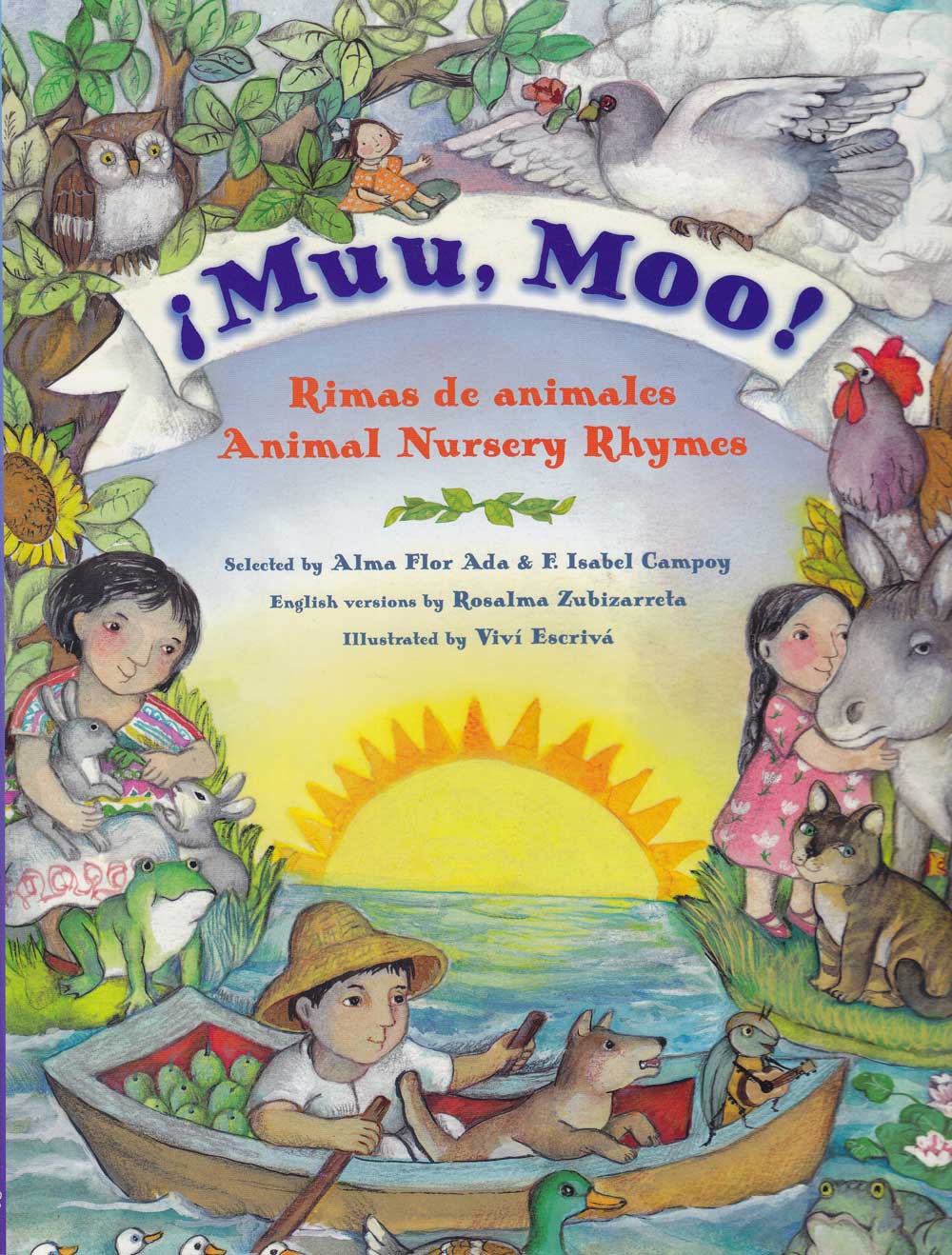 Muu
Moo
Muu
Moo
CCBC Choice by the Cooperative Children's Book Center
A collection of animal-themed nursery rhymes in Spanish, from Spain and Latin America, with English translations.
PreS-Gr 2–The creators of ¡Pío Peep! (2003) and Merry Navidad! (2007, both HarperCollins) have put together another treasury of Spanish nursery rhymes. ¡Muu, Moo! is a collection of animal rhymes that includes such beloved favorites as “Una paloma blanca” and “Debajo de un botón,” along with original verses by both selectors. Rather than a verbatim translation of the Spanish, the English versions retain the rhythm and musicality of the originals. Escrivá’s watercolor illustrations include fun details such as a flea dressed up as a bride, a smiling snail, a frog with a big fly stuck in its mouth, and a dancing monkey wearing a frilly yellow dress. In addition to being a perfect resource for bilingual programs, this book will be enjoyed as a bedtime read-aloud.
Author's Note : It is always an immense source of joy to see a new book published. Isabel Campoy and I have been collecting folklore all our lives. We know the soul of the culture lives in these popular expressions that have been shared from generation to generation through the centuries. It is very meaningful for us to be able to share the children folklore bilingually. Children who are familiar with the Spanish language will be able to enjoy the original rhymes, those that are not fluent yet will be able to enjoy them in English, particularly because the English versions have been lovingly and artistically created by Rosalma Zubizarreta to make them as enjoy able as the originals. These book follows another collection of traditional rhymes, Pio Peep! and one of Villancicos or Christmas Carols, all of them published by Harper Collins with extra ordinary illustrations by Vivi Escriva. A particular element in MuuMoo is that our wonderful editor Rosemary Brosman, understanding the importance that popular poetry remains alive, by being added upon, encouraged us to add some of our own original animal rhymes to the traditional collection. We look forward to your comments as you share MuuMoo with your children or students. May these rhymes continue to live and delight and remain as small treasures in the hearts of children to be held on to forever and some day share with yet another generation of children.
Story Circle Book Reviews : ¡Muu, Moo! is a bilingual collection of seventeen adapted traditional poems and nursery rhymes, from Spain, Latin America, and the United States, centering around animals because the animals interest the young child. Ada and Campoy have included a few of their poems as well. Instead of tranlations, the authors include poetic renditions of the Spanish originals in English, reflecting the charm of the originals. Ada and Campoy chose the selections for ¡Muu, Moo! based on the ability of the pieces to bridge childhood with ancestral roots for Latino children. They focused on tying the past with the present through the included works. Children who speak English only will still delight in the tender words. Viví Escrivá's water color illustrations provide culturally rich backgrounds for the poems. The vibrancy and strength of the Latino culture is evident on each page. Ages: 2-7
School Library Journal : “Rather than a verbatim translation of the Spanish, the English versions retain the rhythm and musicality of the originals....In addition to being a perfect resource for bilingual programs, this book will be enjoyed as a bedtime read-aloud.”
The Children's Book Review : Muu, Muu! Animal Nursery Rhymes by Alma Flor Ada and F. Isabel Campoy is a collection of traditional Spanish nursery rhymes and their English translations. The book is full of beautiful Latin American-inspired illustrations with lots of colorful images.
Katie's Literature Lounge : Alma Flora Ada and F. Isabel Campoy have compiled a selection of sixteen animal nursery rhymes, shared in Spanish. Rosalma Zubizarreta has compiled the English version of the same sixteen. The animal nursery rhymes found within the pages of this particular title come traditionally from Spain, Latin American and the United States. The rhymes are fun, and beautifully illustrated, helping the youngest of children to make a connection between text and context clues found within the illustrations. The following is a list of animal nursery rhymes found within:
Martin Found a
Mouse
Debajo de un boton
Little Brown
Duck
Patito, patito, color de cafe
The Rooster
Cock-a-Doodle-Dows
El gallo Espolon
A White Turtle
Dove
Una paloma blanca
My Dear Little
Rabbit
Mi conejito
My Donkey
El burro
The Meadow
Toads
Los sapitos
The Cat and
the Mouse
El gato y el raton
Fly Hushed
Frog
La mosca a la rana
'Twas Half an
Hour to Midnight
Las once y media serian
The Flea's
Wedding
Las bodas de la pulga y el piojo
Chirp, Chirp
Cri-cri
Spring
Primavera
The Owl
La lechuza
Ramon and His
Dog
Ramon y su perro
The Musical
Cicada
La cigarra guitarrista
Bilingual books are quickly finding a place in my heart, as I have found out that I will have a child in my preschool class next year whose parents speak only Spanish. In order to ensure the success of this child (with the help of her parents), I want to be sure to reach out to them and make them feel comfortable in helping their child in any way possible. Providing that family with bilingual literature will allow them the opportunity to work with their daughter, and at the same time, pick up on a little bit of the English language they are working hard to learn! Because of this, this is another book that will certainly be included in my "literacy backpack" sets! Learning/Reading Activity: Because nursery rhymes (and these in particular) feature lines containing rhyming words, use these nursery rhymes to reinforce the concept of rhyming!
Happy Nappy Bookseller : This is a bilingual collection of traditional animal nursery rhymes from Spain, Latin America and the United States. The nursery rhymes are wonderfully fun and great read alouds. The beautiful and detailed illustrations are a perfect fit. The more I look at this book, the more I love it.
One of my favorite
is My Donkey :
My donkey told me today
his head is hurting, oh my!
The doector said that he should
put on a long black tie.
My donkey told me today
his throat is hurting, oh my!
The doctor said that he should
put on a long white tie.
My donkey told me today
his ears are hurting, oh no!
The doctor said that he should
wear a black hat just so.
My donkey told me today
his heart is hurting, he thinks.
The doctor decided to give him
some lemon syrup to drink
My donkey told me today
he no longer hurts at all
The doctor decided to give him
some apple syrup this fall
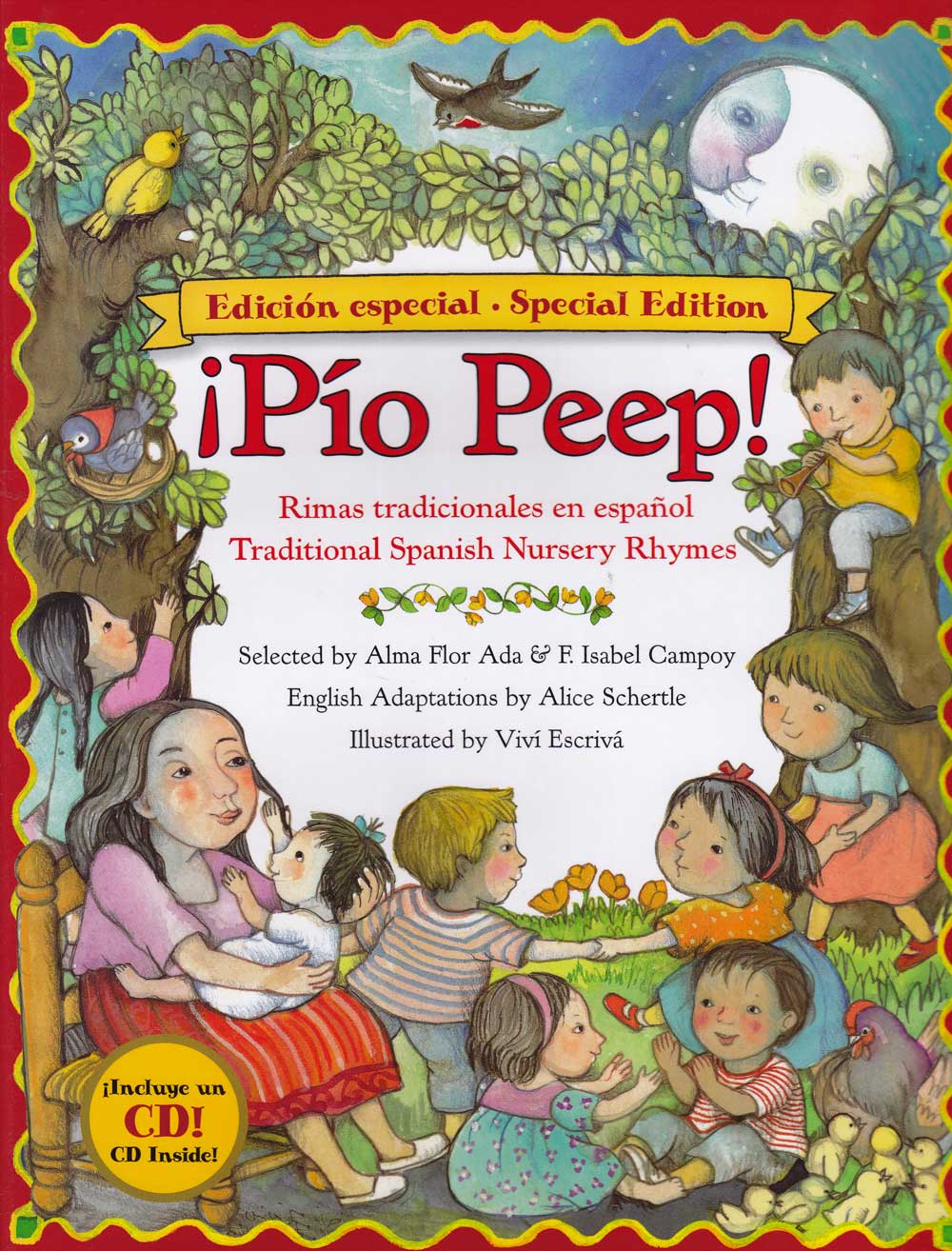 Pio
Peep
Pio
Peep
Here is a groundbreaking bilingual collection of traditional rhymes that celebrates childhood and Spanish and Latin American heritage. From playing dress up to making tortillas, and from rising at daybreak to falling asleep, these joyful rhymes are sure to delight young readers.
Passed down from generation to generation, the twenty-nine rhymes included have been lovingly selected by distinguished authors Alma Flor Ada and F. Isabel Campoy. English adaptations by Alice Schertle capture the spirit of each rhyme and have a charm all their own. Accompanied by enchanting illustrations by Spanish artist Viví Escrivá, this collection is destined to become a beloved classic for children already familiar with the rhymes as well as those encountering them for the first time.
Bulldog Librarian : The author’s intent of this book was to “stimulate children to read” and that’s exactly what it will do. The poems are fun and whimsical and children will gravitate towards them. Because these poems are from an oral folktale background, the rhyming “bounce” to them will keep children and adults entertained. Some of them should also be easy for young readers to tackle independently. The authors collected these rhymes and songs from all the nineteen Spanish-speaking countries in Latin America. They purposely selected well known rhymes so many generations can share the book together. The authors also note the selections are personal to them because they selected rhymes that they cherished in their own childhood. The book contains an informative author’s note, table of contents and introduction page. The author’s note and introduction should definitely be read because they explain the purpose of the book. The authors chose to create a “poetic re-creation” and not just translate the Spanish rhyme into English. Their explanation is helpful and guides the reader into deeper appreciation of the dual language rhyme sets. “Here the Bird Laid the Egg / Aqui puso la pajarita el huevo” (pg 18-19) will be a favorite for students. The plot is simple and easy to understand. The sequence of events is laid out in a timely fashion. With the ending, “and this fat rascal gobbled it up!” kids will cheer because of the simple joke. Students will be able to relate to Escrivá’s watercolor illustrations because the faces look like they do. Like the small nest on page 19, the little details added will delight young readers. “The Elephants / Los elefantes” (pg 32-35) involves simple actions and easily understood humor. Students will quickly grasp that elephants can’t swing from a spider’s web and that there will be some kind of consequence. The anticipation will build and students will have fun deciding what exactly happens next. Escrivá’s large illustrations will appeal to children because the elephants look playful and childlike.
School Library
Journal : PreSchool-Grade 2 Following in the tradition of Margot Griego's
Tortillitas para Mama (Holt, 1995) and Jose-Luis Orozco's Diez deditos (Dutton,
1997) comes this stellar collection of nursery rhymes. Selected from the rich
oral tradition of Latin America and the American Southwest, most of the verses
are known throughout the Spanish-speaking world. The rhymes cover everything
from early morning birds to elephants to angels, and the reason for their
enduring popularity is clear. Deeply rhythmic verses, compelling rhyme schemes,
and words that "play trippingly on the tongue" characterize every
verse. Schertle's excellent English adaptations are not literal translations but
poetic re-creations. They retain the rhythm, meter, and general meaning of the
originals, making the rhymes as memorable and memorizable in English as they are
in Spanish. Escriv 's watercolor and colored-pencil illustrations use
brilliant hues and detail to reconstruct a young child's world. Certain to
become a staple for preschool and early elementary programs, this offering is
also a wonderful, reassuring lap book. A must-purchase for libraries.
Booklist : PreS. As the preface to this delightful book states, nursery rhymes
and songs are an important part of Spanish oral folklore. The 29 rhymes
here--some accompanied by finger plays or games, and some simply meant to be
chanted on their own--in most cases came to the Americas from Spain. They are
presented both in Spanish and in English, although "to preserve the charm
of the original rhymes," the English versions are not translations but
"poetic recreations." Even adult readers with a rudimentary knowledge
of Spanish will see some of the differences, but both versions have a sweet,
rhythmic simplicity that will get children singing, clapping, and perhaps making
some forays into a new language. The watercolor illustrations, featured
prominently on the page, are a mix of historical and contemporary, generic Latin
American scenes, and pictures of animals (not Escriva's artistic strong suit).
Parents, teachers, and librarians will find a multitude of uses.
School
Library Journal : "Stellar…The rhymes cover everything from early morning
birds to elephants to angels."
Amazon :
El sol es de oro
la luna es de plata
y las estrellitas
son de hoja de lata.The sun's a gold medallion.
The moon's a silver ball.
The little stars are only tin;
I love them best of all.
Google : El sol es de oro la luna es de plata y las estrellitas son de hoja de lata. The sun's a gold medallion. The moon's a silver ball. The little stars are only tin; I love them best of all. Here is a groundbreaking bilingual collection of traditional rhymes that celebrates childhood and Spanish and Latin American heritage. From playing dress up to making tortillas, and from rising at daybreak to falling asleep, these joyful rhymes are sure to delight young readers.
Kathy the Crazy Celtic Librarian : This volume is a perfect companion to Jane Yolen’s THIS LITTLE PIGGY which is Anglo-European/American in focus. Thirty poems from the folklore tradition are featured in this bilingual text. It is a multicultural poetry collection with talented and famous contributors. Ada has won dozens of awards and collaborated with the celebrated Spanish artist, illustrator, and marionette maker from Madrid, Vivi Escriva on many volumes. Many will recognize the name Alice Schertle, as an author and poet with over 30 children’s books to her credit. Campoy brings a variety of experiences to play as co-editor of this delightful book. She is a playwright, researcher of Hispanic culture, renowned poet and storyteller. The care and passion woven into the book is obvious after only a page or two is turned. The authors offer a seminal introduction that is more of a plea than a justification for the uses of poetry, folklore, song, and play both in the home and in the classroom. The detailed “About the Authors” page is equally well written and impassioned. Ada states, “The words of nursery rhymes give both wings and roots to my soul.” And that she says is the reason she continually looks for ways to share them with children. Campoy is no less passionate when she proclaims, “The word, when sung, conveys the pleasure of rhythm, just like a beating heart!” The all agree that folklore is often a child’s first experience with literature and be a precursor to learning to read. The poem, “The Little Boat” seems to naturally follow the tune of “Miss Mary Mack” featured in THIS LITTLE PIGGY. The text notes tell us that “Sea Serpent” is played just like “London Bridge.” The book is populated with dolls, angels, tortillas, animals, and cinnamon. It is truly a challenge to choose a favorite verse but I must say that “Now Softy the Roses” and “Sleep Now, My Baby” are noteworthy additions to the collection. As in THIS LITTLE PIGGY finger plays, games, lullabies, and traditional rhymes are included. A wonderful addition to any personal, educational or professional collection.
Lindsey Hammonds : ¡Pio Peep! is a fabulous collection of Spanish oral folklore nursery rhymnes. The original compilation was created by Alma Flor and F. Isabel Campoy. This bilingual book contains the original nursery rhyme and then a "poetic re-creation" of Spanish poems. So although, the poems might not be translated perfectly, the main features and purpose of the story remains true. Poems range from two to ten lines and magnificiently detail the Hispanic culture. The nursery rhymes include stories about birds, five little chicks, a snail, wolf pups, and a boy going to the city to possibly get engaged. Each page contains enormous brightly colored illustrations that take up almost all of the page. In general, on one side of the page is the Spanish poem and then on the other is the English poem. Children will love to read each poem and older bilingual children will love to compare the two rhymes. This collection of traditional Hispanic nursery rhymes will be a great addition to any poetry collection.
A Warner : In this compilation, traditional Spanish language nursery rhymes from Spain and Latin America are represented. The collectors note that the thirty rhymes present were chosen to represent the many traditional Spanish language rhymes. Although the English versions of the rhymes appear next to the Spanish ones, they are not direct translations. Instead, Schertle has tried to capture the essence of the poem and made sure it rhymes in English, even if the words used are different than the Spanish version. A sing-song quality is present in most of the rhymes and exemplified in “Pito, Pito, Colorito:” “Pito, pito, colorito,/ donde vas tu, tan bonito?/ Voy al campo de la era./ A la escuela verdadera.” Whether the reader is familiar with the language, these rhymes beg to be sung aloud. The watercolor illustrations permeate the pages, filling them with greens and blues and infusing the compilation with a sense of growth and comfort. While the difference in poem content between the Spanish and English versions may be distracting to some bilingual readers, the illustrations give the book a unifying quality. The advantages of sharing this collection are numerous, including affirming the important place this culture has in the traditional literature and poetry genres.
Karen's Thoughts : PIO PEEP! Starts by giving brief background information on Spanish oral folklore and how the selections for this anthology were made. The introduction, found in both Spanish and English, explains to parents the benefits of reading poetry and why the English recreations might have slight variations from the original Spanish poems. With poems written in the original Spanish language and accompanied by the English recreations, this poetry collection would benefit the beginning English Language Learner that has an interest in poems. Bright, simplistic illustrations capture the attention of even the youngest children as the poems are read aloud. With the poems coming from the Spanish heritage, Escriva does an excellent job of illustrating the characters so that they accurately and respectfully represent the Hispanic culture, allowing a sense of pride to develop for the Hispanic readers and listeners as the poems are shared with various cultural groups. The poems have a sing-song rhythm that lends itself well to reading aloud with young children.
Lynda Smith : This bilingual collection showcases traditiional Hispanic nursery rhymes. Stemming from oral folklore, these verses have been passed down for many generations. While similar to the types of mother goose rhymes children from North America learned, many retain their own special Hispanic flavor. An example is in the words to Tortillitas para Mama (Tortillas for Mommy) and Arroz con Leche (Rice Pudding) which mention traditional Hispanic foods. La Pinata shows the delight of a traditional game enjoyed by Hispanic children. Other poems about animals and family life could be from any culture but reading them aloud in both English and Spanish adds a special element. The Spanish language has its' own rhythm which sounds very musical even to those who don't understand all the words. Watercolor illustrations beautifully grace each page. Scenes of children playing and enjoying life, animals and nature all create images to complement the poems. This is a beautiful collection to share with young children and is recommended for PreK to grade 2.
Free Webs : For and Campoy have selected 29 traditional Latin American and American Southwest rhymes to include in this poetry collection. All of the poems have a clear rhythm and catchy rhymes with a sense of musical sounds to the listeners, “Pito, pito, colorito,/Donde vas tu, tan bonito?/Voy al campo de la era./A la escuela verdadera.” Schertle has written English adaptations instead of straight translations so the English versions stay true to the original meanings and the rhythm and rhyme of the poems. Escriva’s watercolor and colored pencil illustrations in bright hues lend welcome visuals to enhance each poem. This collection works well for reading aloud, in both English and Spanish, and are also great for one on one sharing.
Lindsay Foster : Even a non-native speaker of Spanish could enjoy this lovely collection of traditional Spanish nursery rhymes. Paired with the Spanish, the English "poetic recreations" offer a unique perspective on the native oral traditions of the Hispanic culture. The soft illustrations are enticing to young and old eyes. When read aloud, the Spanish poems are gently soothing and pleasing to the ear. The twenty-nine different selections express a variety of childhood activities from finger play type games to star-gazing to animal observations.
Early Childhood Literature Review : Summary: The collection of 29 nursery rhymes as presented in this bilingual book will please the young as they listen and sing rhymes that cover many subjects, including animals, children, and home. The authors stated that some of the rhymes and songs came from Spain to America. They selected some of their childhood favorites to include in this book. The watercolor illustrations are very colorful and will appeal to young and old. Comments: The children will enjoy hearing the poems read in Spanish and in English. Children will see their culture and traditions presented in a warm and positive manner. If you do not speak both languages, the children will be pleased to have a mom or volunteer read to them in the second language. This book is appropriate and recommend for the classroom. It is appropriate for toddlers to adults. Alma Flor Ada : Thanks for the gentle review of our book Pio Peep! We indeed enjoyed very much making these beloved nursery rhymes accessible to children in the United States both in English and Spanish. The warm reception the book has had, and its several reprints, tell us that indeed they are being enjoyed. To pass on creations that have been alive for centuries is very satisfactory, a way of acknowledging what we received and an expression of gratitude for the enjoyment that language can provide. Mama Goose is another treasury of oral folklore in both languages that was fun to put together. The recently published Merry Navidad collects Christmas carols organizing them along the various moments related to these cultural festivities. My daughter Rosalma Zubizarreta was able to create English versions that still allow to be sang. Congratulations to the professor who has created this blog and to the students who are writing the reviews. A useful service for all of us who love children's books. With appreciation, in friendship, Alma Flor Ada
Great bilingual book and CD. The CD had great music on it in both Spanish and English. Great way to introduce traditional Spanish poems and music to your young. Wonderful bilingual book.
This book is beautifully illustrated and the little rhymes are wonderful. I have read this book to various ages and it's always a bit hit.
Our baby isn't born yet, but we've started reading to him already. This book has short, fun rhymes in both English and Spanish. We haven't used the CD yet, but I like this book so much that I've purchased it as gifts for several friends also expecting who want their kids to grow up bilingual.
Listen to a sample song from Pio Peep's 29 songs by clicking on the highlighted titles below.
29-Song Blue Pio
Peep Full
CD
A la rueda rueda
Cinco lobitos
Tortillitas para mamá
Aserrín, aserrán
De colores
El patio de mi casa
Caballito blanco
Arroz con leche
Los elefantes
El barquito
Tengo una muñeca
A la vibora de la mar
La piñata
Cuú
A dormir va la rosa
Pajarito que cantas
Duérmete, mi niña
Bread and Cinnamon
Five Little Wolf Cubs
Tortillas for Mommy
Seesaw, Seesaw
Many Colors
In My Backyard
Rice Pudding
My Little Doll
The Piñata
Ribbitt
Little Bird Singing
Sleep Now, My Baby
16-Song Red Pio
Peep Partial CD
A la rueda rueda
Cinco lobitos
Tortillitas para mamá
De colores
Arroz con leche
Cuú
Pajarito que cantas
Duérmete, mi niña
Bread and Cinnamon
Five Little Wolf Cubs
Tortillas for Mommy
Many Colors
Rice Pudding
Ribbitt
Little Bird Singing
Sleep Now, My Baby
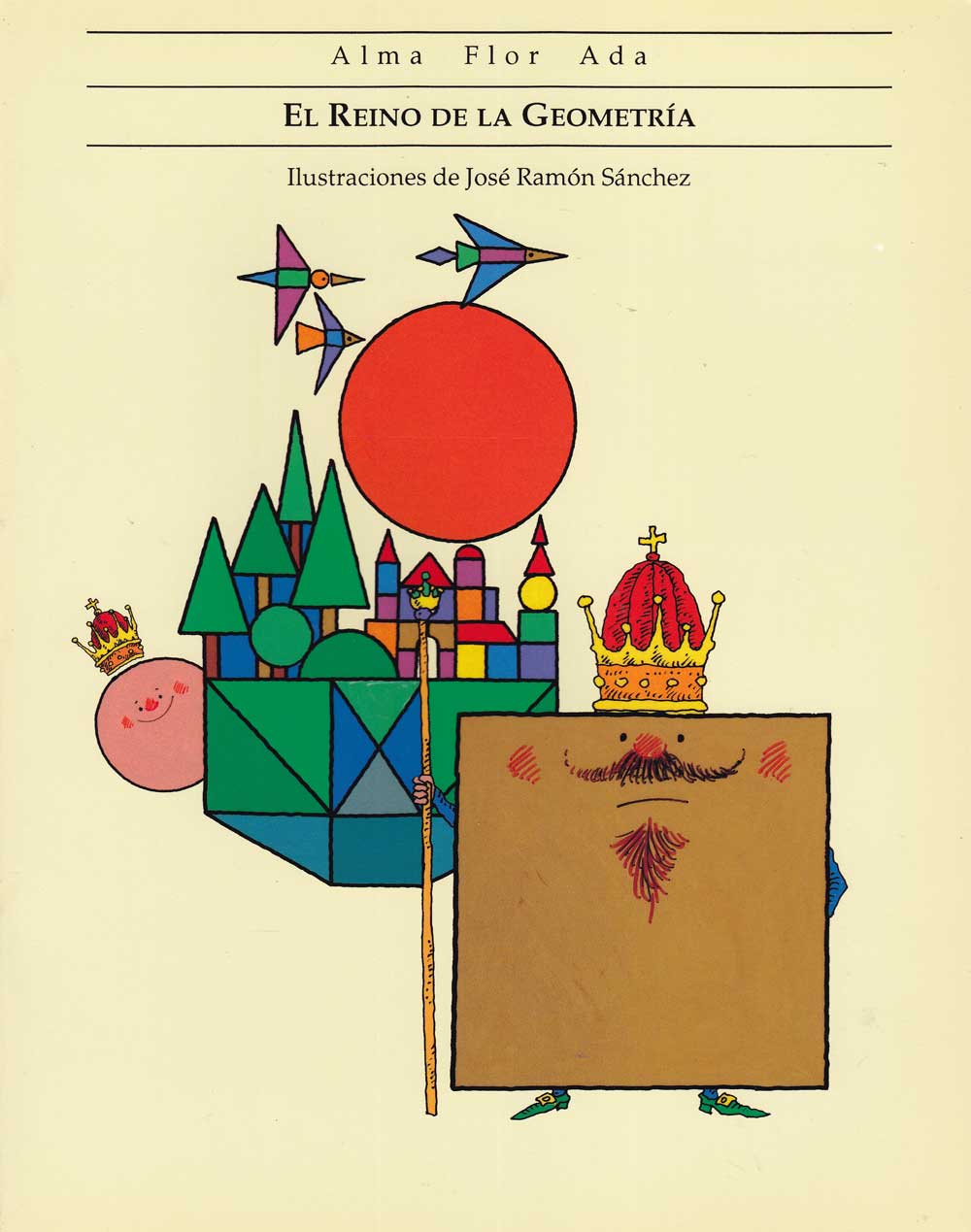 Reino de la geometria
Reino de la geometria
Everyone lives happily in the Kingdom of Geometry until King Square VII comes to the throne, Persuaded by his courtiers that a square is the perfect figure, with four identical sides and four square angles, he decrees that only squares shall be allowed in the palace and in the town. It takes much ingenuity and determination on the part of a young square named Rose, to free the remaining figures from the king’s rule. This is a story to initiate reflections on injustice, discrimination and racism, as well as possible responses to oppression. The illustrations are by the famous Spanish artist José Ramón Sánchez.
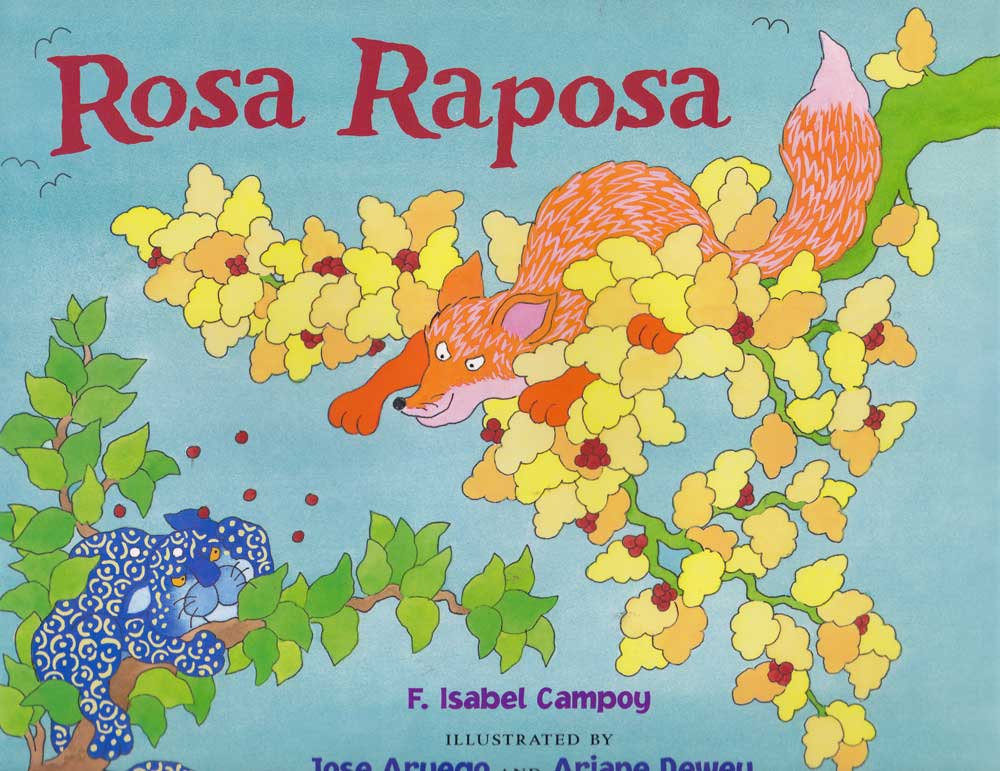 Rosa
Raposa
Rosa
Raposa
Jaguar, the sharp-toothed, beady-eyed bully, is determined to eat Rosa Raposa for dinner. But Jaguar had better watch out, because clever Rosa has some surprises in store for him! In three hilarious South American trickster episodes, Rosa uses her sharp imagination to make Jaguar look like the biggest fool in the forest. F. Isabel Campoy and bestselling illustrators Jose Aruego and Ariane Dewey have created a story that will keep readers wondering how Rosa Raposa will get the last laugh this time.
Watch
or Listen Vienna
Rose read Rosa Raposa to you. A marvelous example of the magical
encounter between a child and books that we wish for all children. And
here's an earlier
reading by Vienna Rose, and an even earlier
reading.
School Library Journal : Kindergarten-Grade 3-Campoy sets three Spanish
trickster tales in the Amazon Rainforest, where a little fox uses her wits to
extricate herself from Jaguar's bullying threats. In "A Cry for Help,"
Chango-monkey helps Jaguar when he is trapped in a hole, only to be threatened
by the hungry animal when he is free again. Rosa goads Jaguar into showing them
once more how he was snared, and then leaves him there. In "A Strong North
Wind," Rosa is caught by Jaguar, pretends there is a hurricane, and
convinces her adversary to be tied to a tree so he won't blow away. In "The
Green Dress," Rosa outwits not only Jaguar, but angry bees as well, and
calls to Jaguar from one side of a wide river, "I hope I don't see you
again." "Oh, you will, Rosa Raposa, you will," responds her
nemesis on the other side, slinking away, raising readers' hopes that more
stories are on the way. The pen-and-ink, gouache, watercolor, and pastel
illustrations are wonderful, bright, and saucy. This is a delightful book for
read-alouds, reinforcing the idea that brains are better than brawn.
Booklist : K-Gr. 3. Campoy adapts three trickster tales from Spanish
stories about a fox that bests a wolf and resets them in the Brazilian Rain
Forest, changing the wolf to a jaguar. In each of these short stories, fox Rosa
Raposa evades hungry Jaguar. First she convinces him to leap into a pit, then to
tie himself to a tree, and finally she camouflages herself with leaves. Aruego
and Dewey's signature pen-and-ink, gouache, and watercolor illustrations play up
the trickery's humor and cheerfulness with expressive characters and bright,
tropical colors--Jaguar is blue spotted with white and Rosa is vibrant orange
and pink. An author's note offers some background and word definitions [ …]
the combination of Rosa's wily thinking; the well-paced text, with a rhyme at
the end of each chapter; and the sprightly pictures will make for lively read-alouds.
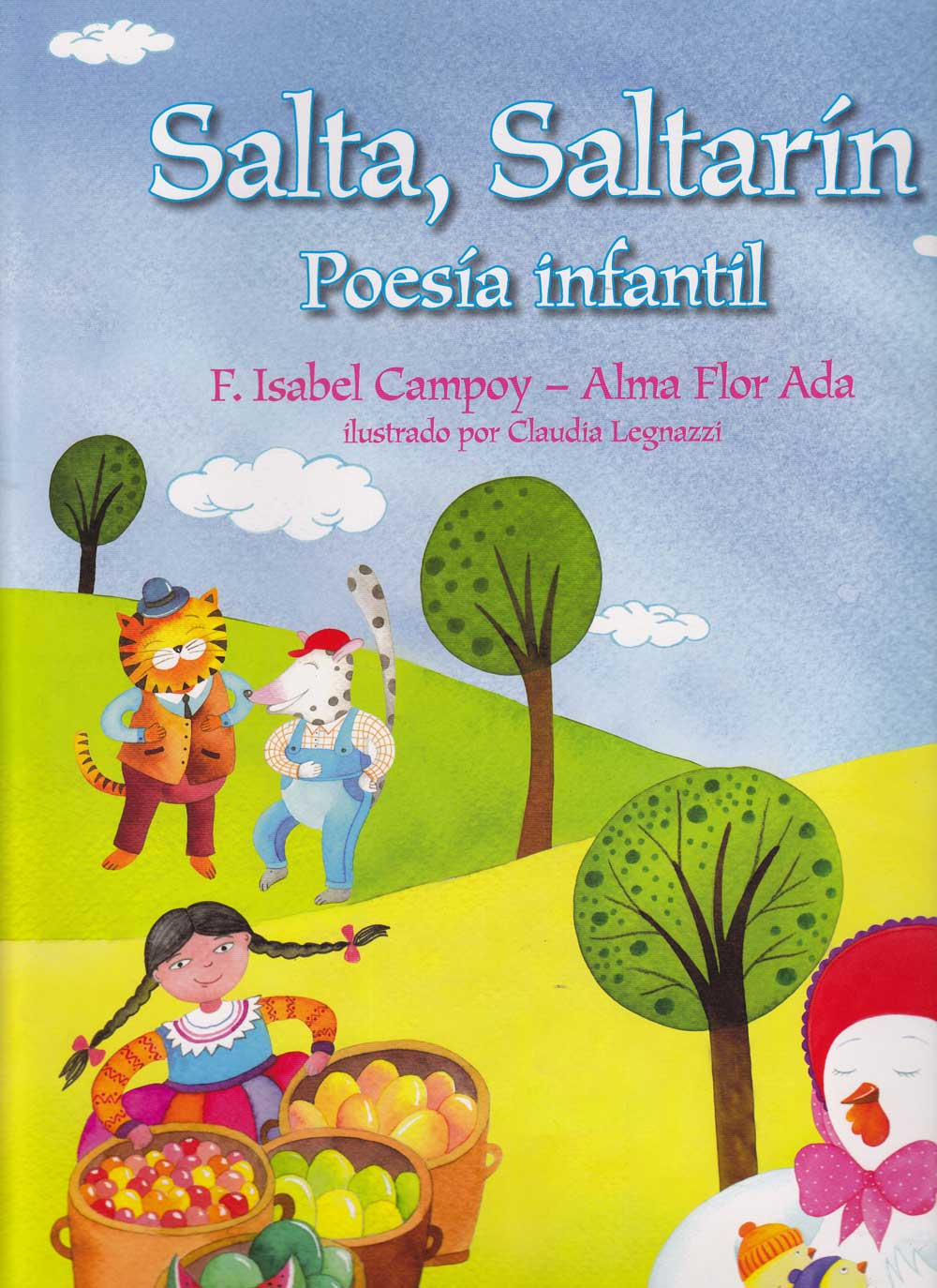 Salta
Saltarin
Salta
Saltarin
A collection of poems for young children by Alma Flor Ada and F. Isabel Campoy.
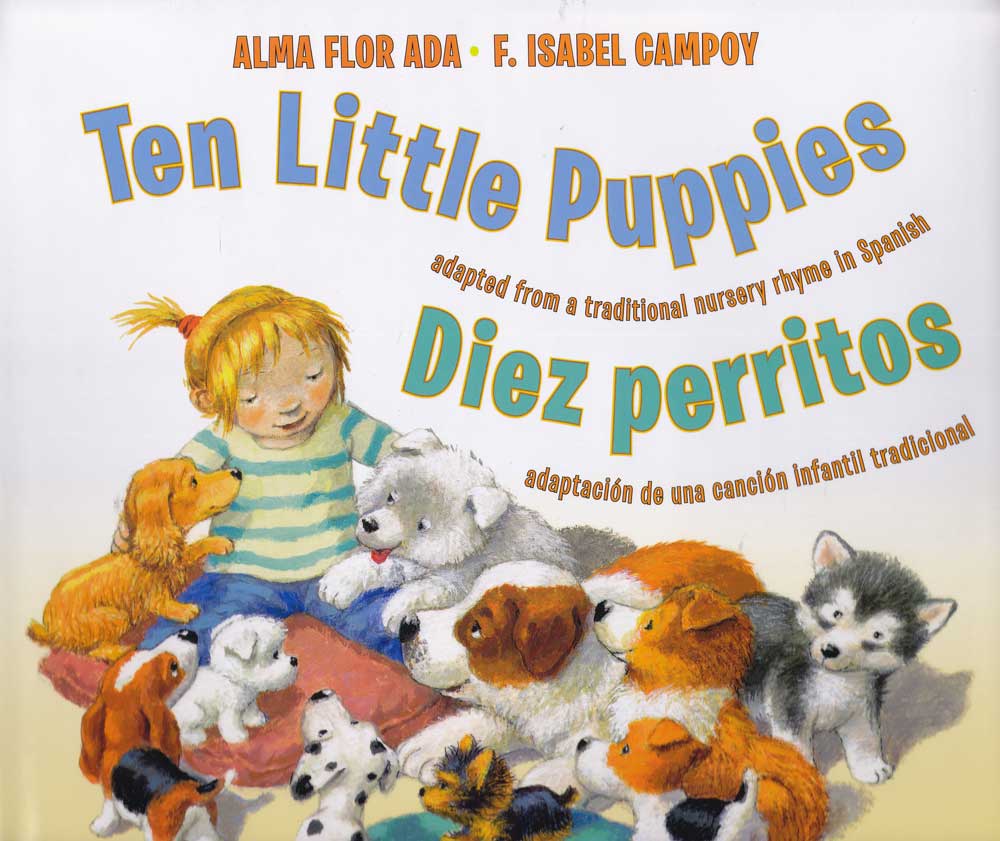 Ten
Little Puppies
Ten
Little Puppies
Oh, I had ten little puppies,
Ten little puppies had I . . .
Count along in Spanish and English as each one of the ten adorable puppies disappears from the pages—it's a bilingual bonanza! Colorful and playful illustrations by artist Ulises Wensell, a vibrant rendition of the classic Spanish nursery rhyme by Alma Flor Ada and F. Isabel Campoy, and a delightful English adaptation by Rosalma Zubizarreta will make this edition an instant family favorite. And you can find more information at the back of the book about the puppy breeds featured. Puppies have never been so irresistible!
Yo tenía diez
perritos,
diez perritos tenía yo . . .
Ahora puedes contar, en inglés o en español, cada uno de los diez adorables perritos mientras van desapareciendo de las páginas. ¡Una verdadera joya bilingüe! Las originales y divertidas ilustraciones del artista Ulises Wensell, la vibrante versión de la rima clásica de Alma Flor Ada y F. Isabel Campoy, y una excelente adaptación en inglés de Rosalma Zubizarreta harán que este libro sea indispensable en todos los hogares. Puedes encontrar más información acerca de las razas de los cachorros en la parte posterior del libro. ¡Nunca has visto perritos más irresistibles!
School Library Journal : In one of the most popular counting rhymes in Spanish folklore, 10 adorable puppies decrease by one with each page turn. Enticements such as snow, pastries, fireworks, a new home, theater, sickness, and fun cause the puppies to move on, until only one remains as a beloved companion for a child. Vibrant colored-pencil and watercolor illustrations are done in deep hues of green, pastels, and earth tones to create realistic images that capture the spontaneous, playful, and affectionate nature of the pups. The text can be sung or spoken in Spanish or English. The English translation skillfully utilizes rhyme to maintain the story's authenticity while accurately reflecting the original poem. The back section contains musical notation of the melody, guitar chord symbols, the bilingual verses in their entirety, and a glossary with information about the 10 dog breeds featured. Large, appealing illustrations will make this a favorite for storytime presentations; an excellent source in helping children to develop prereading skills, and a fun way to introduce them to early math concepts such as addition and subtraction.
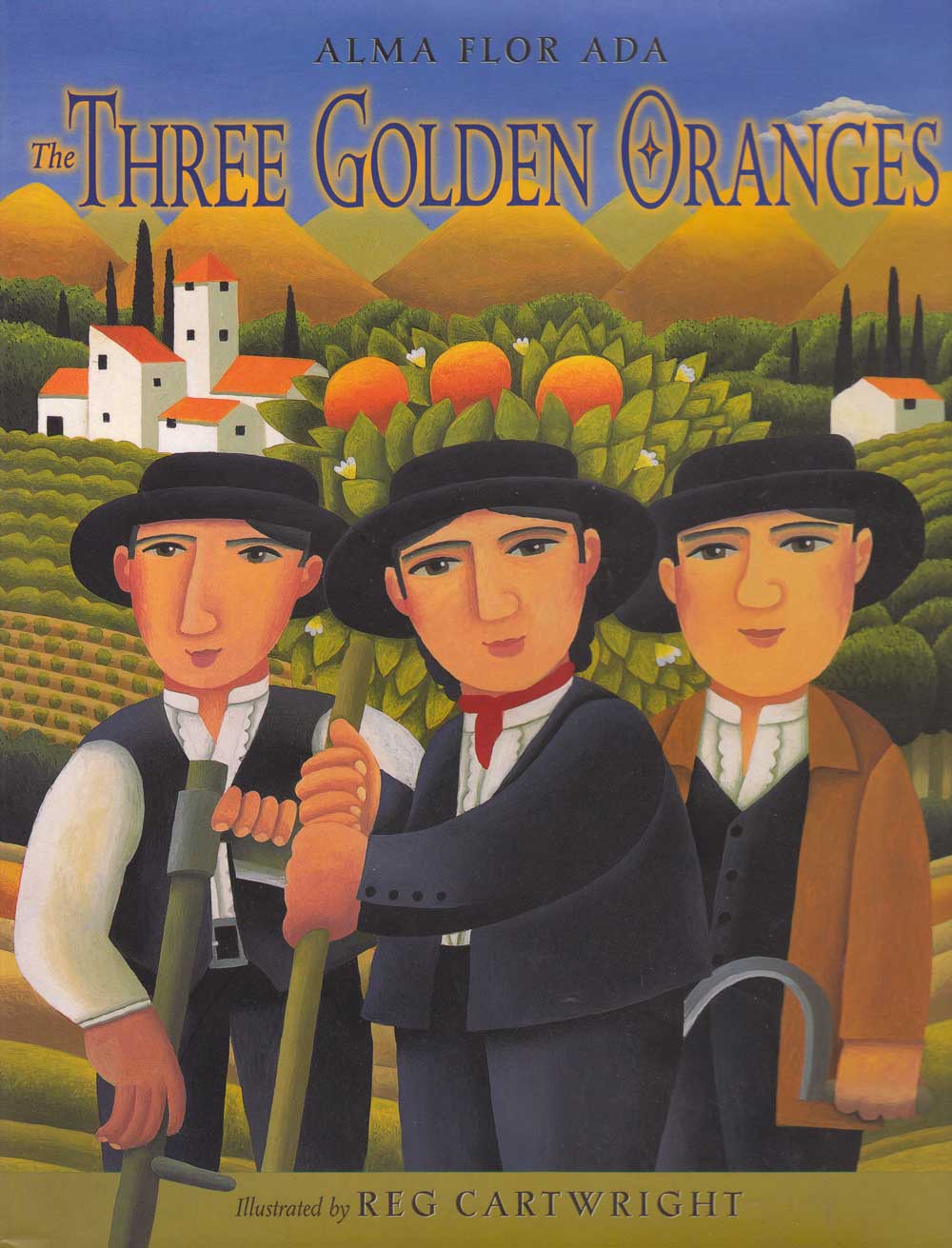 Three
Golden Oranges
Three
Golden Oranges
2008 CALIFORNIA READERS' COLLECTION : MIDDLE SCHOOL LIST
A poetic and magical retelling of a traditional Spanish folkltale that celebrates a spirit of cooperation and brotherly love. The inspiring illustrations are by Reg Cartwright.
Author’s Note : The Spanish folklore is abundant in wonderful tales, as diverse as the country from which they originate. Many of them were brought to Spain by the Arabs, who inhabited large areas of the Iberian Peninsula from 711 to 1492. The magic characteristic of the stories of One and a Thousand Nights, is somewhat present in this tale of enchantment. I’m very happy that one of my forthcoming books is a collection, written in collaboration with Isabel Campoy, of traditional folktales of Spanish-speaking countries to be published by Atheneum.
Listen to Vienna Rose read The Three Golden Oranges to you. A marvelous example of the magical encounter between a child and books that we wish for all children. And here's an earlier reading by Vienna Rose.
Publishers Weekly : Ada adds feminist panache to her retelling of the classic Spanish folktale. Mat!as and his two older brothers wish to wed, but there is not a single unmarried girl in all their lush valley. The old woman who lives on the cliff by the sea has the answer: if they travel to a distant castle, pick three golden oranges and bring them to her, each brother will have the wife he desires. But they must work together or, she cautions, "Woe to you if you do not follow my advice." Mat!as, the only one to comply, wins his destined bride, the kind Blancaflor, and she helps him to save both his brothers and her bewitched sisters. Ada's author's note cites no specific source for her retelling, but does contrast her Blancaflor tale with some of the more popular versions. As in her original fairy tale, The Malachite Palace, she adopts a straightforward, sometimes bland narrative voice ("When Mat!as... saw that there was only one orange left, he felt very sad for his brothers"). But the artwork will sustain readers' interest. Cartwright's (The Band Over the Hill) vivid and varied vignettes and spot illustrations rendered in flat, round shapes and bold colors evoke folk art while displaying a sense of life and movement. The pictures here are as succulent as the oranges themselves. Ages 5-8.
School Library
Journal : Grade 1-5-In this well-known Spanish folktale, three brothers are
instructed by their mother to find wives. An old woman advises them that they
must work together and tells them to travel to a castle grove, pick three golden
oranges, and together bring them back to her. The two older brothers, who are
vain and shallow, disregard her advice and are put into the castle's prison,
where they are rescued by Mat!as, the compassionate youngest son who follows the
woman's directions and gets the fruit. On the way home, the older brothers open
their oranges and once again find themselves in the dungeon. When Mat!as brings
his fruit back to the old woman, she cuts it open and a dove flies out. Later,
he removes a thorn from the bird's neck and it turns into a young woman named
Blancaflor. They return to the castle and free her family from a spell. Mat!as
marries Blancaflor, but her sisters refuse to marry his brothers. Cartwright's
flat, folk-art style characters wear traditional Spanish costumes. The yellows,
greens, and oranges in the rounded patchwork countryside contrast with the black
of the brothers' clothing and bright blue skies. Full-page illustrations
alternate with smaller pictures to move the eye and relieve the long text. Ada
keeps the story as simple as its many twists and turns allow, but this is still
a complicated tale. An author's note discusses variations of the folktale and
how oranges fit into Spain's history.
Booklist : In this version of a popular Hispanic folktale, three brothers in
search of brides are told by an old woman that they will each find the wives
they want--if they work together. She sends them on a quest to bring her three
golden oranges. Of course, the two oldest try on their own and fail, and the
youngest pulls them together. In a nice twist, he is finally rewarded by a
strong bride who chooses him. The text is long, sometimes too long, especially
with the repetition of the pattern of three; but the telling is lively, the
message is light, and the stylized oil paintings in bright colors combine magic
and personality, rhythm and character, with a strong sense of drama.
Kirkus Reviews : Ada (Under the Royal Palms, 1998, etc.) reworks the traditional
story of Blancaflor, taking swipes at greed, vanity, and the practice of
arranged marriages in the process. Some well-traveled types help make the
points: older brothers full of themselves and not above treachery; the innocent,
well-intentioned youngest brother; a wise older woman; and a young woman in dire
circumstances, with the moral fiber to endure. Here the story revolves around
three brothers wishing to wed, and how they seek the advice of an elderly woman
and then ignore all her warnings. The two bad-of-heart brothers wind up in a
castle jail, and then marriageless; Matas, the pure one, liberates a family
under a sorcerer's spell, gains love and marriage, and fulfills his mother's
wishes. Ada invests her lengthy retelling with a quiet musicality that softens
the predictability of the narrative. Meanwhile, the Spanish countryside comes
blazingly alive under the bold illustrations of Cartwright's stylized, utterly
transporting artwork. (Picture book/folklore. 5-8)
Latin Baby Book Club : LBBC’s recommendation for the August Libro del Mes, is Alma Flor Ada’s The Three Golden Oranges. Ada’s adaptation of the classic Spanish fairytale is spectacular with changes to the original story line that create a tale that flows simply and beautifully. The story of three brothers who wish to marry and set out to find the woman of their dreams, they first visit the wise old woman who lives in a cave on the edge of a cliff. Spinning her wool, the old woman tells them how to find the brides that they are seeking. Naturally, two of the brothers (Santiago and Tomás) do not heed the old woman’s advice and promptly get into trouble, but the third, Matías, follows the directions as best he can and is eventually rewarded with the apparition of the kind and joyful, Blancaflor. The two quickly return to the castle to rescue both Matías’ brothers (trapped in the castle dungeon) and Blancaflor’s mother and sisters - who, along with Blancaflor, had been cruelly transformed into an orange tree with –tada! – three golden oranges! Unlike most fairytale endings in which the handsome prince is rescuing the princess with his extraordinary strength, agility and dashing good looks, Three Golden Oranges emphasizes the value of honesty, selflessness, honor, and dedication. When asked what type of wife he wants, Matías asks for one who is "kind, joyful and someone I could love very much" as opposed to his brothers who desire wealth and beauty. And in a novel turn of events, it is the sweet Blancaflor who chooses Matías to be her husband, rather than the other way around! Yay! Altogether what a great message…and one that I hope to impart to my own son and daughter. Set in rural Spain, the illustrations are fantastic. Reg Cartwright does a great job depicting the Spanish characters in both their attire and features (aquiline noses are just so Mediterranean – I should know!) And his colorful, rounded artwork vividly reflects the Spanish countryside and small towns with a folk art style. If you would like to buy your own copy of The Three Golden Oranges, please click here. Or you can follow the link in our sidebar to the LBBC’s on-line store. We have both new and gently used copies available. And be sure to leave us a comment to let us and other blog readers know what you think about the book. Happy reading!
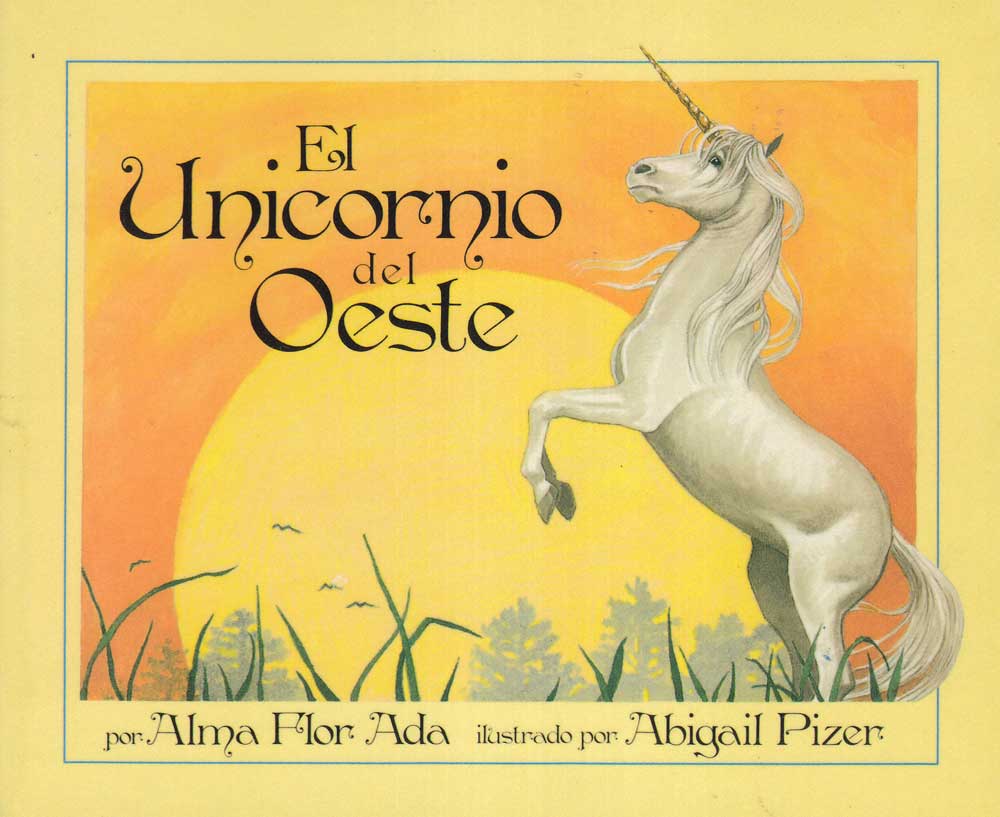 Unicornio del oeste
Unicornio del oeste
Unicorn of the West
In this evocative tale of friendship and self-discovery, a young unicorn undertakes a magical journey in order to find his purpose. Excellent for discussing themes of identity and solidarity. The beautiful illustrations are by Abigail
Pizer.
Author’s Note : This story was born out of the request of my great-nieces Virginia Marie, Lauren and Allison Roure De Miranda for a bedtime story. When I asked them what they wanted the story to be about they requested “unicorns”. So, inspired by their beauty and their trust on my storytelling abilities I began: “Each evening, as the sun set…” and the book was born. It has always been one my favorites, perhaps because of my love for the girls who inspired it, and their mother, my niece
Virgilú.
Listen to Vienna Rose read The Unicorn of the West to you. A marvelous example of the magical encounter between a child and books that we wish for all children. And here's an
earlier reading by Vienna Rose.
School Library Journal : Grade 1-3-A gentle story that can be effectively shared on many levels. A young unicorn who has never before met any other creatures of the forest tries to discover who he is. With each season, he meets a different animal: a spring robin, a summer butterfly, an autumn squirrel. But it's not until winter approaches that he hears a "melody" that seems to beckon him to a place where he meets the Unicorns of the East, South, and North. They tell him that he is the Unicorn of the West and that every seven years on the solstice, the four meet to insure that each corner of the world will always know love and beautiful dreams. The unicorn returns home, content to know his identity and with the knowledge that he has true friends. In The Gold Coin (1991) and My Name Is Maria Isabel, (1993, both
Atheneum), Ada employed similar themes of self-discovery. Here, it is interwoven with the idea that both friendship on an individual level and peace on a universal level are important. The story is well told and folkloric in its approach as a pattern is developed and repeated with each encounter with a different animal. The watercolor illustrations are soft without being pale and portray an apt world for this original fable.
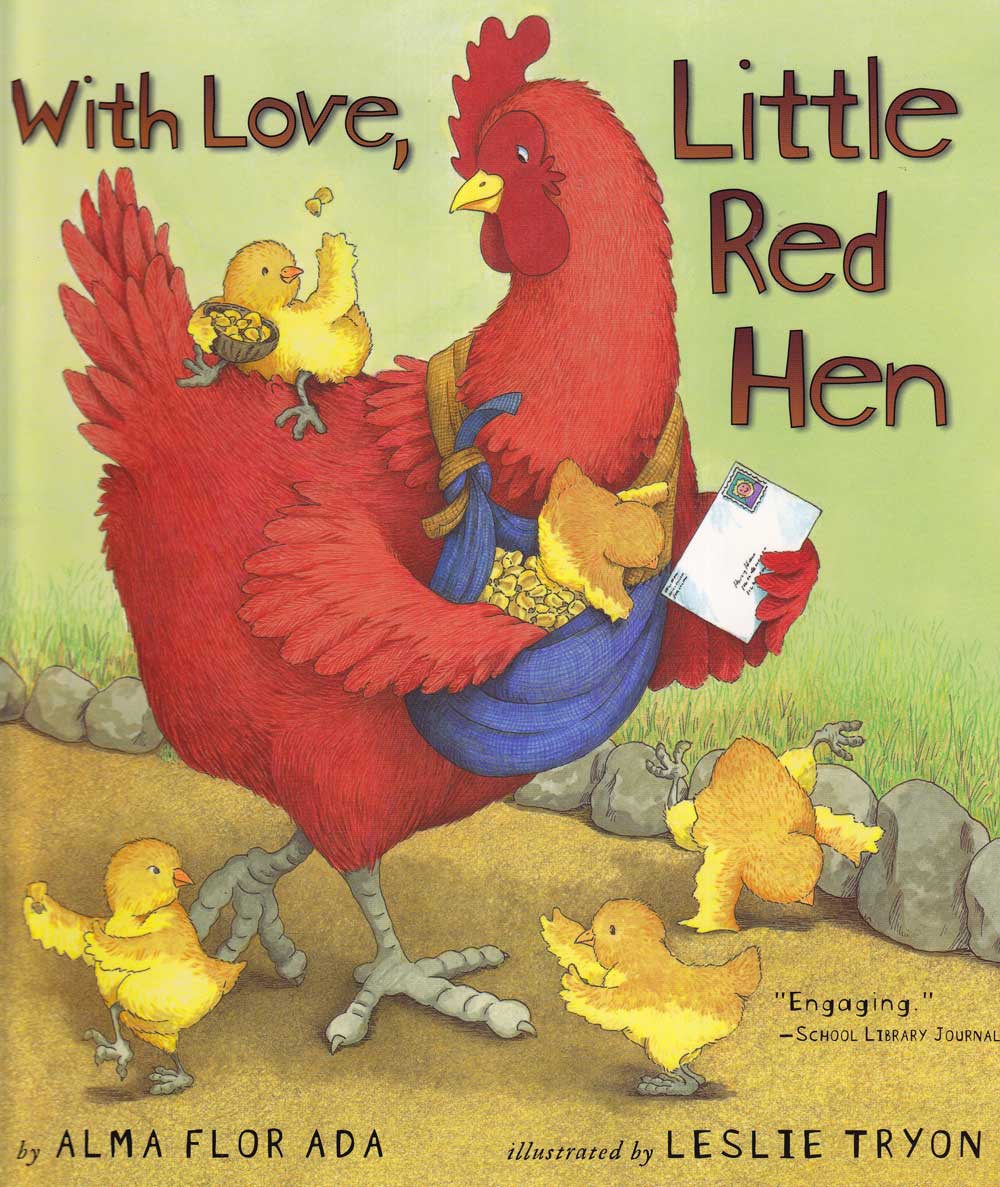 With
Love Little Red Hen
With
Love Little Red Hen
Hidden Forest has a new resident. Little Red Hen and her seven little chicks have moved into a cottage and plan to grow a bountiful crop of corn in the nearby field. The problem is that none of the Red Hen's neighbors are willing to help with the hard work. "Not I," says the dog, the goose, and the lazy cat. So Goldilocks, who has heard about the new arrivals from her friend Little Red Riding Hood, comes up with a neighborly idea: Why don't all the residents of Hidden Forest chip in and work on the garden? Better yet, why not make it a surprise? Of course there are a couple of residents who might not be so cooperative. Will Wolfy Lupus and his cousin Fer O'Cious hatch a new plot of their own?
Author's Note : The Little Red Hen has always been one of my favorite fairy-tale characters. Both as the hardworking gal who does not hesitate to do all the work by herself or as the resourceful hen who loves to saw and finds in her scissors, thread and needle the means to escape her captor. In both episodes she shows the best traits of the female personality. For this third book in the Hidden Forest series, following Dear Peter Rabbit and Yours Truly, Goldilocks, I chose to have two different hens, Little Red Hen and her cousin, Hetty Hen, carry each of the stories. I made them cousins in honor of my own, who have always been very dear to me. I chose to make Hetty Hen single, in honor of the beautiful and strong single women in my family, among my aunts and nieces. On the other hand, I made Red Hen have seven chicks. The magic number were the number of grandchildren I had at the time, to whom I dedicated the book. But they were really inspired by my own four very helpful children. The presence of the chicks and the solidarity expressed by Little Red Riding Hood give a new flavor to the story, which ceases to be totally individual is tic although continues to stress fairness.
Listen to Vienna Rose read With Love, Little Red Hen to you. A marvelous example of the magical encounter between a child and books that we wish for all children. And here's an earlier reading by Vienna Rose, and an even earlier reading, and the earliest reading.
With
Love Little Red Hen
PowerPoint Project by Megan Starzl
School Library Journal : K-Gr 3 In this engaging sequel to Ada's Dear Peter Rabbit (1994) and Yours Truly, Goldilocks (1998, both Atheneum), the Little Red Hen and her chicks move into the Happy Valley section of the Hidden Forest. The hen's request for help from her lazy neighbors is met with the familiar chorus, "Not I." She writes of her new surroundings and adventures in letters to her friend Hetty Henny. Little does she know that she is the topic of conversation in letters between Little Red Riding Hood and Goldilocks, who secretly decide to give her a hand. But not all is happy in Happy Valley with Wolfy Lupus and Fer O'Cious trying to make meals out of their neighbors. Hetty has a close call, but her scissors, needle, and thread provide her with a way out of trouble. Finally, when the Little Red Hen throws a party for her neighbors, the bad guys lose their opportunity to make a chicken dinner and slink off in shame and disappointment. Tryon's charming pen-and-ink with watercolor illustrations depict a bucolic paradise with neighbors who look out for one another.
Booklist : Ages 5-8. Like Dear Peter Rabbit (1994) and Yours Truly, Goldilocks (1998), this addition to an imaginative series once again comprises letters between beloved storybook characters. Correspondence here describes the Little Red Hen's arrival in the Hidden Forest, an enchanted place where a number of familiar storybook characters reside. Ada does a great job entwining the lives of previously unrelated characters into one intriguing story. Tryon's realistic, highly detailed watercolor and pen-and-ink illustrations are equally appealing, especially the splendid double-page spread depicting the celebratory party Little Red Hen throws for the friends who helped her plow and plant the field. It's not essential for youngsters to be familiar with the previous books or with the stories on which the letters are based, but having background will certainly add to enjoyment.
Publishers Weekly : Alma Flor Ada returns to the Hidden Forest a third time for With Love, Little Red Hen, illus. by Leslie Tryon, once again relaying her tale through correspondence from storybook characters. Little Red Riding Hood, Goldilocks and others surprise the industrious but stressed-out Ms. Hen by secretly cultivating her corn, while two wolves plot to kidnap her for a chicken dinner.
Cahners Business Information : Dear Peter Rabbit (1994) and Yours Truly, Goldilocks (1998, both Atheneum), the Little Red Hen and her chicks move into the Happy Valley section of the Hidden Forest. The hen's request for help ... more » from her lazy neighbors is met with the familiar chorus, "Not I." She writes of her new surroundings and adventures in letters to her friend Hetty Henny. Little does she know that she is the topic of conversation in letters between Little Red Riding Hood and Goldilocks, who secretly decide to give her a hand. But not all is happy in Happy Valley with Wolfy Lupus and Fer O'Cious trying to make meals out of their neighbors. Hetty has a close call, but her scissors, needle, and thread provide her with a way out of trouble. Finally, when the Little Red Hen throws a party for her neighbors, the bad guys lose their opportunity to make a chicken dinner and slink off in shame and disappointment. Tryon's charming pen-and-ink with watercolor illustrations depict a bucolic paradise with neighbors who look out for one another.
Amazon : Hidden Forest has a new resident. Little Red Hen and her seven little chicks have moved into a cottage and plan to grow a bountiful crop of corn in the nearby field. The problem is that none of the Red Hen's neighbors are willing to help with the hard work. "Not I," says the dog, the goose, and the lazy cat. So Goldilocks, who has heard about the new arrivals from her friend Little Red Riding Hood, comes up with a neighborly idea: Why don't all the residents of Hidden Forest chip in and work on the garden? Better yet, why not make it a surprise? Of course there are a couple of residents who might not be so cooperative. Will Wolfy Lupus and his cousin Fer O'Cious hatch a new plot of their own? Following the highly acclaimed Dear Peter Rabbit and Yours Truly, Goldilocks, Alma Flor Ada and Leslie Tryon offer young readers another peek into the world of their favorite storybook characters, revealed through the charming letters they write to one another.
Teaching K-8 : Writing to Red Riding Hood - We all know that letter-writing is meaningful "real-world" writing practice for kids. The following books include letters that are a bit out-of-this-world. With Love, Little Red Hen, by Alma Flor Ada includes letters from such favorite characters as the Little Red Hen, Little Red Riding Hood, Goldilocks and the Wolf. The author tells that, after finding her grandparents' letters, she discovered that correspondence can tell a story, and indeed it does in this delightful book. Students can study one of the book's letters with a partner or in a small group and discuss the information contained in it. Middle grade students could rewrite their own letters to the characters who are listed in the "Hidden Forest Directory" at the end of the story. Alma Flor Ada has two other similar books, Yours Truly, Goldilocks, Dear Peter Rabbit.
To Order or to Ask
a Del Sol Question, read the Del
Sol Order Info and then email Rey Del Sol
![]()
333 N Main Street, # 2464, Cedar
City, UT, 84720
